

















































































































Come to Friends Homes to enjoy a fresh approach to active, meaningful living.



At Friends Homes, spring is a vibrant, energizing time when our beautiful campus comes to life with engaging activities and events. It’s also a wonderful time to experience our welcoming culture and whole-person approach to wellness firsthand with more options than ever for dining, lifelong learning, fitness, art, music and more.
Join our Resident of the Future waitlist to receive priority access to available apartments, townhomes, or cottages. Scan the code to download your personalized brochure, or feel free to call or visit us for more information.





• City Council news
• City project updates
• Arts and entertainment
• Job postings
• Road closures
• And more!




Dr. Edward Gronet Board-Certified Plastic Surgeon

Dr. Edward Gronet, Board-Certified Plastic Surgeon, has been selected as a Castle Connolly Top Doctor, a prestig ious distinction awarded to only the top 7% of physicians in the Uni ted States. This honor recognizes Dr. Gronet's exceptional clinical expertise, as well as his outstanding interpersonal skills, ensur ing patients receive the highest standard of care and personaliz ed attention.
At H/K/B MedSpa, we offer the latest advanced treat ments designed to rejuvenate and enhance your natural bea uty. Spring is the ideal time to refresh and revitalize your skin. Whether you're looking to restore youthful radiance or smooth and tighten skin, our expert team is here to help you feel your best and welcome the season with a refreshed glow.

Having a banker who’s available and easy to reach is important. We make sure we are accessible to the most important people we work for... you.
People who bank with us know they can reach us.
A Way of
By Cassie Bustamante Ann Tilley makes her mark as lightly as possible 56 Buffalo Presbyterian Church By Jim Dodson
From generation to generation, Greesnboro’s pioneer church lives on
Architectural Details
Cannot Resist By Cynthia Adams (Hint: Porches rock our worlds)
66 From Central Park to Fisher Park By Maria Johnson

A big-city transplant brings verve to a 100-year-old bungalow 79 April Almanac By Ashley Walshe
IllustratIon by H arry blaIr
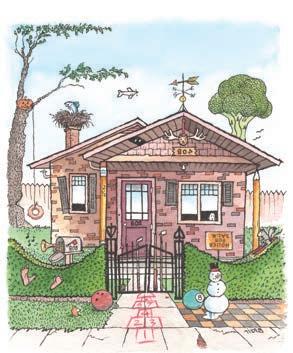
What’s wrong with our cover? Artist Harry Blair went to town on our April Fool’s-themed illustration of our Fisher Park feature house, inspired by Highlights magazine. Answer key:
Jack-o’-lantern in tree
Donut swing
Fish in bird’s nest
Shutter falling off
Downspout pointing up
Tree being axed in wrong direction
Bowling ball on lawn
Feet in bush
Trumpet playing in mailbox
Hopscotch missing “5”
& 13. house numbers backwards (and not a match)
Gate made of golf clubs, arrow and pool stick
Gate finial upside down
Eight ball on lawn and wrong color
Snowman in spring
Airplane upside down
Squirrel skiing shrub slope 20. Broccoli tree 21. “For Sale” sign upside down
Ghost in window
23. Shutters too short 24. Eyes peering out from eaves
25. Cat head with antlers
26. One bird flying upside down 27. Weathervane coordinates
Tiled lawn
29. Front door hinge backwards
30. Artist name backwards
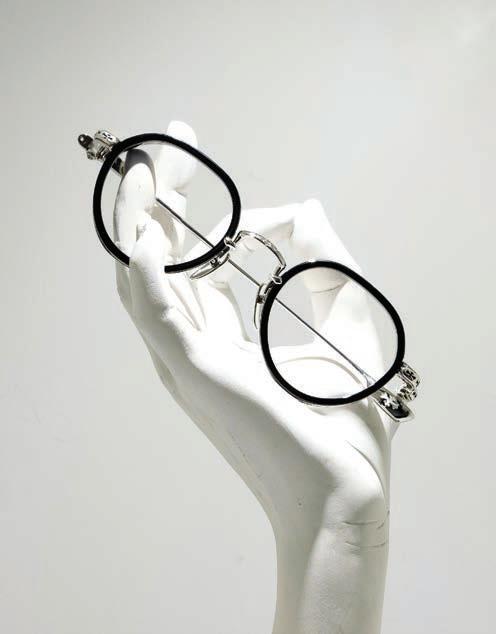
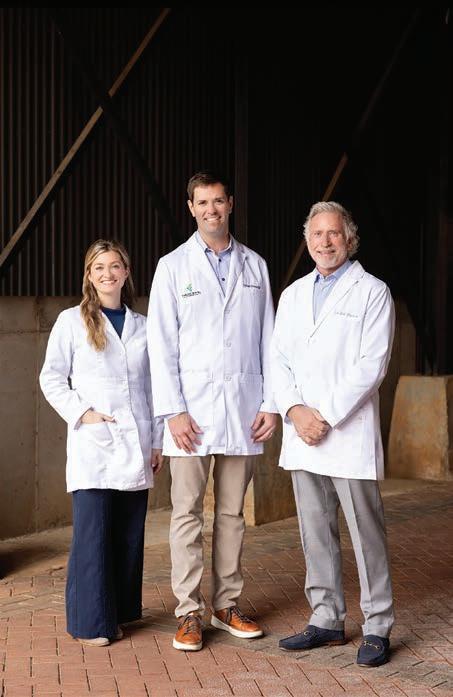



volume 15, No. 4
Volume 15, No. 4
“I have a fancy that every city has a voice.” www.ohenrymag.com
“I have a fancy that every city has a voice.” www.ohenrymag.com
PUBLISHER
PUBLISHER
David Woronoff
David Woronoff david@thepilot.com
david@thepilot.com
Andie Rose, Creative Director andiesouthernpines@gmail.com
Andie Rose, Creative Director andiesouthernpines@gmail.com
Cassie Bustamante, Editor cassie@ohenrymag.com
Cassie Bustamante, Editor cassie@ohenrymag.com
Jim Dodson, Editor at Large jwdauthor@gmail.com
Jim Dodson, Editor at Large jwdauthor@gmail.com
Keith Borshak, Senior Designer
Keith Borshak, Senior Designer
CONTRIBUTING EDITORS
CONTRIBUTING EDITORS
Cynthia Adams, David Claude Bailey, Maria Johnson
Cynthia Adams, David Claude Bailey, Maria Johnson
CONTRIBUTING PHOTOGRAPHERS
CONTRIBUTING PHOTOGRAPHERS
Betsy Blake, Ivan Saul Cutler, Lynn Donovan, Amy Freeman, John Gessner, Becky VanderVeen, Bert VanderVeen, Mark Wagoner
Betsy Blake, Ivan Saul Cutler, Lynn Donovan, Amy Freeman, John Gessner, Becky VanderVeen, Bert VanderVeen, Mark Wagoner
CONTRIBUTORS
CONTRIBUTORS
Harry Blair, Anne Blythe, Susan Campbell, Jasmine Comer, Ross Howell Jr., Billy Ingram, Tom Maxwell, Gerry O’Neill, Liza Roberts, Eric Schaefer, Stephen E. Smith, Zora Stellanova, Ashley Walshe, Amberly Glitz Weber
Harry Blair, Anne Blythe, Susan Campbell, Jasmine Comer, Ross Howell Jr., Billy Ingram, Tom Maxwell, Gerry O’Neill, Liza Roberts, Eric Schaefer, Stephen E. Smith, Zora Stellanova, Ashley Walshe, Amberly Glitz Weber
ADVERTISING SALES
ADVERTISING SALES
Lisa Allen
336.210.6921 • lisa@ohenrymag.com
Lisa Allen
336.210.6921 • lisa@ohenrymag.com
Amy Grove
336.456.0827 • amy@ohenrymag.com
Amy Grove 336.456.0827 • amy@ohenrymag.com
Brad Beard, Graphic Designer
Brad Beard, Graphic Designer
Jennifer Bunting, Advertising Coordinator ohenrymag@ohenrymag.com
Jennifer Bunting, Advertising Coordinator ohenrymag@ohenrymag.com
Henry Hogan, Finance Director 910.693.2497
Henry Hogan, Finance Director 910.693.2497
Darlene Stark, Subscriptions & Circulation Director 910.693.2488
Darlene Stark, Subscriptions & Circulation Director 910.693.2488
OWNERS
OWNERS
Jack Andrews, Frank Daniels III, David Woronoff
In memoriam Frank Daniels Jr.
Jack Andrews, Frank Daniels III, David Woronoff
In memoriam Frank Daniels Jr.
© Copyright 2025. Reproduction in whole or in part without written permission is prohibited. O.Henry Magazine is published by The Pilot LLC
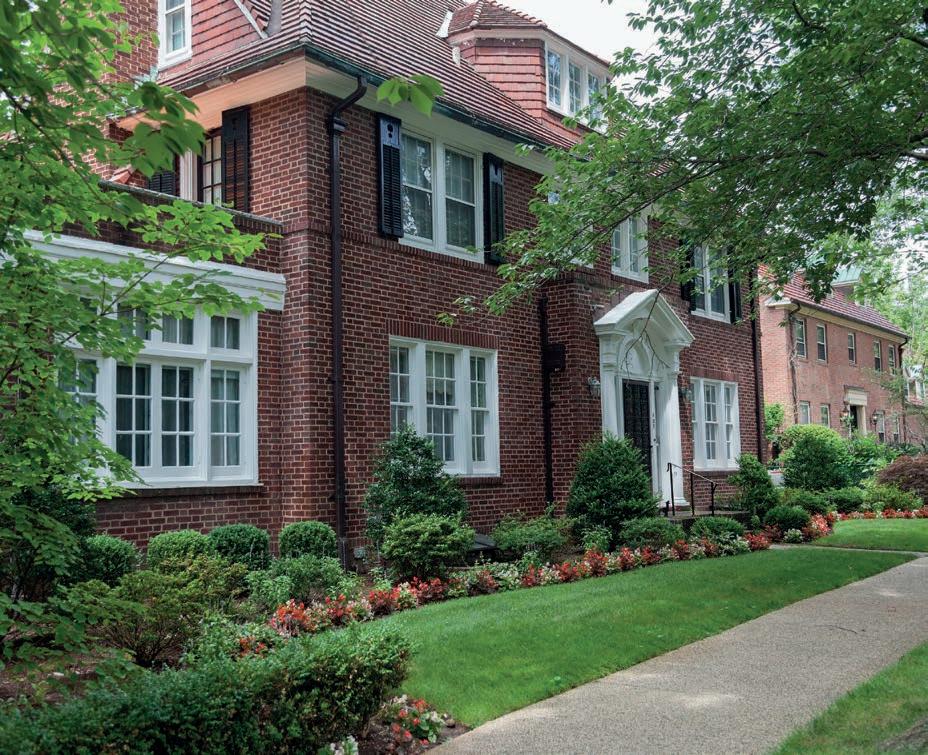
Inventory of homes for sale is at an all-time low. If you are considering selling your home, now is a great time! As partners in the Triad’s largest locally owned real estate company, both Tyler Redhead & McAlister (Greensboro, Asheboro) and Leonard Ryden Burr (Winston-Salem), have professional agents ready to help.
What is your home worth? Scan to find out.




By Cassie Bustama Nte
By Cassie Bustamante
A bit of a fixer-upper
The summer I turned 7, my family moved from small-town Upstate New York to Wilbraham, a small-town in Western Massachusetts. Picture quaint, 200-year-old homes, churches surrounded by old, stone walls and even a very old, red schoolhouse-turnedabode. Everywhere you looked, the streets bubbled over with New England charm. But our new house? Not so much. It bubbled over with ick.
My mother and I made the trek across states together, leaving my father behind to cheer on my older brother, Dana, who was playing in a little league tournament. I hadn’t yet seen any photos of the new digs, but I’ve always thrived on change and the opportunity to meet new people. And, this time, we were moving to be closer to family. We’d be in the same town as both sets of grandparents and close to all sorts of cousins, aunts and uncles.
In fact, Wilbraham was the town where my parents met as high school students with backyards abutting one another. Back then, my dad wore his white-blonde hair in a 1970s swoop that cascaded in front of his eyes, suiting his shy personality. My mom, a petite brunette with a Farrah Fawcett ’do, was gregarious and often teacher’s pet. Come to think of it, a lot like me. It wasn’t until they both enrolled at Springfield College in the fall of 1974 that sparks flew.

When my brother arrived a week later, he had the same reaction. In fact, he packed a suitcase and said he was going to ride his bike back to New York and live with friends. I wondered how he’d manage the suitcase while pedaling, but I never witnessed that level of stunt mastery because he stayed.
Beyond the front door, the family room featured the inevitable ’60s faux-bois paneled walls and linoleum flooring that vaguely resembled bricks. The tacky residue left behind by a rug adhesive attracted the fur of our golden retriever, Butterscotch. In fact, every surface seemed sticky and dirty.
But it was as if Mom and Dad could see into a crystal ball, which magically showed them something I couldn’t see — the spark of potential underneath all that grime. They rolled up their sleeves and got to work. In sections, they replaced wooden siding along with rotten windows. They repainted the exterior a soft gray and gave it new barn-red shutters, a color combo that still remains in place today, according to my Google search, almost 40 years later. I recall many days spent outside, flipping over rocks in search of salamanders, while Dad sat atop the house with his cousins, hammering down a new roof.
All along the drive, I chattered away excitedly, driving Mom bonkers. The anticipation came to a jarring halt when we pulled into a driveway. This could not be it. I prayed that this was some kind of joke and, surely, Mom was about to shout, “Gotcha!” In front of me stood a dilapidated, brown 1964 Colonial with red shutters — the worst color combination known to man — and an attached two-car garage. The paint was blistered and peeling, rot everywhere. This was it? I wept.
Grampa, Dad’s dad, was a self-made entrepreneur who owned a wholesale hardware company, and thus understood the world of home renovation. He’d appear from time to time to “help” Dad with weekend warrior projects. But not until he’d sat on the porch munching on a donut and sipping coffee, followed by playing basketball with me and my brother in the driveway. And then, “Oh, would you look at that? I’ve got to go if I am going to make my tee time!” Maybe he took it too easy, but we all look back on those moments with laughter. Cancer took his life way too soon just a couple years later when he was just 59. On weekends when repairs weren’t being made, Bob Vila’s voice rang through the kitchen while I ate my grilled peanut butter sandwich, This Old House playing on our wooden console television set in the nearby family room. YouTube and TikTok were still decades away from being created, kids. My parents had to learn about DIY through reading books and checking the Sunday paper’s TV schedule to make sure they didn’t miss their favorite DIY shows.
Mom, an avid gardener who knew just what would thrive

Jim Bunn is grateful for all the fun, friendship, and purposeful living he enjoys at Arbor Acres. “There’s something here for everybody—concerts, lectures, movies, croquet, volunteering, fine dining. You name it.” Jim enjoys walking around the beautiful community, visiting with friends, then tending the beauty in his back yard, where he’s planted about 20 rose bushes. “This place nurtures you, at the same time it inspires you to nurture and to help others.”

Discover life in all its shining brilliance at Arbor Acres.
where, planted flowers aplenty to create a lush and vibrant yard. Lilac bushes lined our white picket fence. Just outside the back door, an herb garden’s fragrance wafted through our kitchen window all summer long. We teasingly called it the “Herb”— with a hard “H” — garden, naming it after the endearing, out-of-shape man in one of Mom’s Jane Fonda exercise videos.
My parents poured everything — blood, sweat, tears and what little money they had — into making that hideous monstrosity a jewel of the neighborhood. As a 6-year-old, I hadn’t understood the possibility, but as a 46-year-old I’ve learned something about compromise and seeking out hidden potential.
Arbor Acres is a Continuing Care Retirement Community affiliated with the Western NC Conference of the United Methodist Church.
1240 Arbor Road, Winston-Salem, NC 27104 arboracres.org • (336) 724-7921
Over the 21 years that my husband, Chris, and I have been married, we’ve bought a few well-worn homes. And every one, we’ve made our own with paint and — like my parents — blood, sweat, tears and all the money we could muster. When we arrived in Greensboro in January 2019, the 1960s Starmount Forest ranch home we moved into was far from a looker, but it ticked the boxes for a family of five. Though our new house was not nearly as neglected as my childhood home in New England, my own kids felt a little like I had the day I arrived in Wilbraham with my mom. The magic simply wasn’t there. But, thanks to my parents, I’ve realized that magic is something you create through a combination of creativity, hard work and collaboration that includes the kids. And as the months have turned into years, we’ve turned a house into a home, one that our two older kiddos will look forward to returning to next fall when they’re both away at college. That is, until they have their own fixerupper to make their own. OH
Cassie Bustamante is editor of O.Henry magazine.























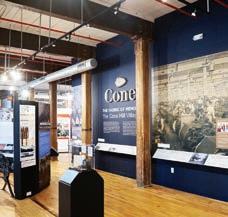

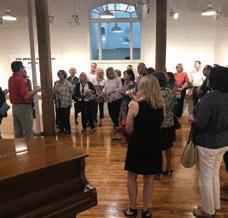





By Jim DoDsoN
By Jim DoDson
Xx OH
Editor’s note: Xx
I celebrate April’s return every year because it’s the month that a divine awakening changed my life.
Jim Dodson is the founding editor of O.Henry. His 17th book, The Road That Made America: A Modern Pilgrim Travels the Great Wagon Road will be published by Avid Reader Press and is available for pre-order on Amazon. Find his weekly writings and musings at jwdauthor.substack.com.
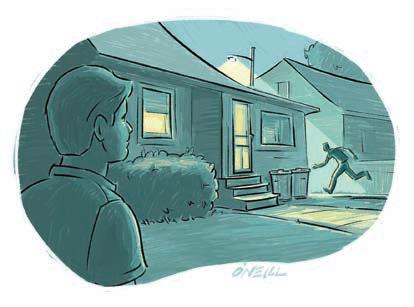
It was 1980. I was the senior writer of Atlanta Weekly, the Sunday magazine of the Journal-Constitution, the oldest newspaper magazine in the nation. It was probably the best writing gig in the South. Over the previous three years, I’d covered everything from presidential politics to murders in the “City Too Busy to Hate,” as Atlanta liked to promote itself in those days.
One minute I was interviewing a grand dragon of the Ku Klux Klan in Alabama, the next riding along with the Repo King of Atlanta as he repossessed cars in the city’s most dangerous federal housing project, a shotgun on the seat of his truck. I’d also written several pieces about young women from the South who were drawn to Atlanta’s bright lights only to wind up murdered or missing.
Looking back, though I didn’t realize it then, I was in search of an answer to a question that had no answer.
Three years before I snagged that job, Kristin, my girlfriend back home in North Carolina, was murdered in a botched holdup by three teenage boys at a Hickory steakhouse where she worked as the weekend hostess. I’d left Kristin on a beautiful October Sunday after making plans to get married and move with her to England, where she had a job as an understudy awaiting her in London’s West End.
The low point of my Atlanta odyssey came on a hot July night in 1979. I was working on a cover story about Bob Stivers, the city’s famous medical examiner, whose forensic sleuthing reportedly inspired the popular TV show Quincy. The week before that Saturday night, I’d watched half a dozen autopsies at the ME’s elbow, equally mesmerized and horrified. When Stivers invited me to ride along with the squad that picked up murder victims, I jumped at the chance. Saturday nights were particularly busy in the city that had recently been declared America’s “Murder Capital.”
My new fiancée, Hank Phillippi, was the nighttime weekend
anchor at WSB-TV. We shared an old, brick house near the east-side entrance to Piedmont Park. Our weekend routine was to have a glass of wine and watch Saturday Night Live when Hank got home from the studio before midnight.
On that fateful night, waiting for a call from Bob Stivers’ death crew, as I was standing in the darkness of our backyard, waiting for my dog, Magee, to do her business, I saw a car pull up beside our neighbor’s house. We were friendly with the Emory med students who lived there.
As I watched, a man emerged from the backseat of the car and calmly walked to our neighbor’s backdoor and knocked. A med student still in scrubs opened the door. There was a brief exchange of words, followed by two gunshots. The medical student collapsed on the ground. The assailant bolted for the running car, which sped away.
By the time I reached his side, a young woman from the house was screaming hysterically. I asked her to fetch me a couple towels and call 911.
Fortunately, at that moment, Hank arrived home. She took charge and phoned the police as I cradled the wounded man in my lap, attempting to keep him conscious. He died 15 minutes before cops arrived. “We get drug hits like this every weekend,” the cop said.
I chose not to follow the victim’s body down to the city morgue.
The next morning, though, as I was walking Magee, I heard a chapel bell in the distance softly chiming “Blessed Be the Tie That Binds,” one of my favorite hymns since childhood. Tears filled my eyes.
As Hank slept in, I fetched a cup of coffee, sat on our front steps taking stock of my life, and suddenly realized what was missing. I hadn’t been to church in five years.
I got dressed and went to services at the historic All Saints’ Episcopal Church downtown, famous for feeding the homeless and never locking its front doors. The rector, a wonderful man named Harry Pritchett, gave a powerful sermon about how God finds us in the darkness when we least expect it. It felt like he — or maybe God himself — was speaking directly to me.
Not only did I begin attending All Saints’ regularly, but also made a decision in favor of writing stories that enriched life rather
than revealed its dark side. I even set my mind on attending seminary, until a wise old Bishop from Alabama named Bill Stough, the editor of the Bishop’s Fund for World Relief, convinced me to follow a “ministry closer to your heart,” as he put it. “You are a born writer,” he said. “You can serve the Lord better by writing about life than becoming a parish priest.”
Not long after that harrowing summer night, Hank and I called off our engagement, but have remained dear friends for more than 45 years.
As for me, that following April while working on a sample story about youth baseball tryouts, I ventured over to a rundown ball field in my midtown neighborhood, where a desperate league director convinced me to take on the coach-less Orioles. They were a wild bunch, many of whom lived in Federal housing. This was during the peak days of the “Missing and Murdered” crisis affecting Atlanta’s Black teens. I made a deal with my team’s families to drive them home after all games and practices.
I also made a deal with my rambunctious “Birds”: If they played hard and behaved like gentlemen, I would buy them all milkshakes after winning games.
They took the offer to heart. We won the Midtown League Championship in a romp that season, which convinced me to stick around Atlanta for one more year. We went undefeated for a second time. It only cost me 200–300 milkshakes.
I never wrote another crime story again.
Crazy as it sounds, almost a year to the day later, I woke on an April night to find Kristin standing beside my bed. She looked radiant. I thought I must be dreaming, but she was so lifelike, especially when she smiled and spoke. “Pook,” she said, using her pet name for me, “it’s time for you to leave here and go north. That’s where you’ll find what you are looking for. I’ll always love you.”
Days later, I resigned from the magazine, turned down what might have been a dream job in Washington, and headed for a trout stream in Vermont.
God, Kristin and my baseball team found me in the darkness when I least expected it.
It’s been a wonderful life ever since. OH
Editor’s note: Today, Hank Phillippi Ryan has collected multiple Emmy and Edward R. Murrow awards for her groundbreaking consumer, on-air journalism. She is also a celebrated investigative on-air reporter based in Boston and author of 15 bestselling psychological thrillers — winner of five Agatha Awards. The woman knows a thing or two about human darkness.
Jim Dodson is the founding editor of O.Henry. His 17th book, The Road That Made America: A Modern Pilgrim Travels the Great Wagon Road, will be published by Avid Reader Press and is available for pre-order on Amazon. Find his weekly writings and musings at jwdauthor.substack.com.











"A spirited forum of Gate City food, drink, history, art, events, rumors and eccentrics worthy of our famous namesake"
"A spirited forum of Gate City food, drink, history, art, events, rumors and eccentrics worthy of our famous namesake"
Paperhand Puppet Intervention’s mission is anything but pedestrian: tell stories, beat drums, work up a sweat, push boundaries . . . and steal people’s hearts away all while making the world a better place. Through largerthan-life puppets, Paperhand transports audiences into a world where greed, hate and fear are defeated, while love of the Earth and its creatures triumphs. Combining papier-mâché, house paint, cardboard and silk, puppet-makers in their Saxapahaw studio bring to life characters mythic in scope and kaleidoscopic in hue. Two decades worth of drawings, marionettes, shadow puppets, and clay and papier-mâché characters will be on display at GreenHill Center for NC Art from Saturday, March 22 (public opening 3–5 p.m.), until Saturday, June 21. Check GreenHill’s website for music, performances and hands-on cardboard-puppet fabrication as part of its ArtQuest program, plus a series of events, including a robot-costume family night and parade (April 5), an Earth Day Celebration (April 19), an artist talk (May 14) and a workshop (June 7). Discover how you can change the world with your own two hands, just as as Paperhand Puppets have. Info: www.greenhillnc.org/of-wings-and-feet
Xx
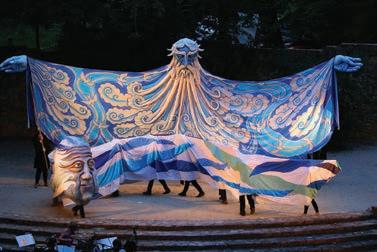
Here at O.Henry, we are all about literacy. After all, our namesake is one of America’s greatest short-story writers. The month of April honors a different kind of literacy — financial. Turns out, our namesake was not so hot at that and, in fact, served five years in Texas prison on charges of embezzlement. So, while we wouldn’t recommend taking money advice from the man himself, here’s our two cents on the subject. Make a grocery list and stick to it. Unless, of course, the Tillamook ice cream is BOGO.
Build an emergency fund. Also, define “emergency.”
A 401K, as its name suggests, is a very long race, but, when you reach the finish line, the participation trophy is worth it. Put in the work and go the miles. Before you know it, you’ll be retiring in the lap of luxury. Invest. And we don’t mean in Beanie Babies. With the help of a financial advisor, invest in stocks. Or invest in yourself — earn more accreditations or learn new skills that bring added value to your resumé.
Cancel unnecessary subscriptions. Lucky for you, there are free magazines for your entertainment. Like the one in your hands.
O.Henry

Xx
Whether your thumb is vivid green or you’re chlorophyll deficient, The Greensboro Council of Garden Clubs is opening the vine-covered gates on six private — though not necessarily secret — gardens. This year’s tour features the secluded beds in the neighborhoods of Irving Park, Sunset Hills and Starmount Forest. Traipse through backyard wonderlands so enchanting that they exceed Lewis Carroll’s wildest dreams and wander onto front lawns bordered by lush bushes, flowering vines and blooming bulbs galore. You’re sure to head home mulch inspired and ready to dig into your own outdoor oasis. Plus, you’ll have a chance to mingle with club members while exploring how you can become a part of their growing community, too. Plentiful fun awaits! Tickets are $25 each and, as of April 1, can be purchased at A. B. Seed, The Extra Ingredient, Fleet-Plummer, Guilford Garden Center, Plants & Answers: The Big Greenhouse, and Randy McManus Designs. The tour runs from 10 a.m. to 4 p.m., May 17 and 18. Info: facebook.com/gcgcinc.

Plot twist? On April 2, 1936, a tornado ripped through the south end of Greensboro. The storm created a path of destruction 11 miles long, extensively damaging some buildings, including the former Blue Bell factory shown here. Restored to its former glory, it serves as home to Centric Brands and Transform GSO on the northwest corner of Gate City Boulevard and South Elm Street.

But first, rules.
But first, rules.


When O.Henry’s team decided to put a twist on our annual writing contest, we ended up with what some will see as a twisted creative writing contest. We want you to write your own obituary — a faux-bituary, if you will. But this is no grave matter. No, this is an opportunity to dredge up the wit, humor and magic from your darkest depths. If you need inspiration, google “Idaho witch Holly Blair obituary.” Blair crafted her own whimsical memorial and it had us wishing we’d known her when she was alive. Or take, for instance, Renay Mandel Corren’s obituary, written with such love and hilarity by her son Andy Corren that it went viral, spurring him on to author Dirtbag Queen: A Memoir of My Mother, which released earlier this year. Maybe this is your own memoir in the making. Every day, we’re buried in deadlines and daily housework. Imagine, instead, just being buried — six-feet-under buried — and how you’d want to be remembered.
Submit no more than 250 words in a digital format — Word or Pages document, a PDF, pasted into an email, or carved into stone and sent via photographs. More than 250 words? You’re dead to us.
Submit no more than 250 words in a digital format — Word or Pages document, a PDF, pasted into an email, or carved into stone and sent via photographs. More than 250 words? You’re dead to us.
One submission per person: Email entries to cassie@ohenrymag.com
One submission per person: Email entries to cassie@ohenrymag.com
Deadline to enter is July 31, 2025.
Deadline to enter is July 31, 2025.
Winners will be contacted via email and their submissions will be printed in a forthcoming issue.
Winners will be contacted via email and their submissions will be printed in a forthcoming issue.
Lastly, life is short. Have fun with this assignment.
Lastly, life is short. Have fun with this assignment.
In one of my favorite flicks, Tim Burton’s Mars Attacks!, Jack Nicholson as POTUS makes a final appeal to the Martians who have invaded Earth, pleading, “Little people . . . why can’t we all just . . . get along?” His answer comes after he shakes hands with the take-me-to-your-leader commander of the attack, whose hand detaches and proceeds to stab the president in the back, a Martian flag popping up from his corpse.
Let’s admit it. It’s pretty obvious from the evening news that we humans don’t get along very well with one another, and in this dog-eat-dog world, things aren’t much better for man nor beast.
But plants. Those trillium, trout lilies and anemones bursting into bloom all around us, they certainly know how to get along. Or do they?
Unless you’ve been hiding under a garden rock, one of the hottest horticultural topics in recent years has been
plant communication. In an article entitled, “Plants Can Talk. Yes, Really,” Mamta Rawat, a program director at the National Science Foundation, muses, “I think we’re seeing that the complexity [of communication] is just as great with plants as it is with animals.”
And it ain’t all friendly.
Researchers have discovered that leaves can trigger defenses when they detect predators. When some roots sense problems with nutrients, water and predators, they respond accordingly. Plants even signal nearby kin telling them that the ever-dreaded aphids (or Martians) have landed.

In fact, gardeners have had a solution for this problem for centuries. It’s called companion planting. Basil disorients moths that lay tomato hornworm eggs. Aphids can’t stand garlic! Nasturtiums lure caterpillars away from your kale, cabbage and broccoli. You can read all about these and other suggested pairings at www. almanac.com/companionplanting-guide-vegetables.
Relying on the latest scientific info instead










of old wives’ tales, Benedict Vanheems, longtime contributor to Kitchen Garden, Britain’s longest-running garden magazine, digs into which plants love one another and which ones wage war on the competition. Asparagus thrives with petunias and tomatoes close by. And, yes, it makes sense to plant squash so it shades the roots of corn and to plant pole beans to climb up corn stalks. Cabbage loves garlic, nasturtiums and sage as neighbors. Peas pair well with lettuce, radish and spinach. And both zucchini and summer squash love oregano, nasturtiums and zinnias. Chemicals similar to humans’ pheromones are at work in many of these cases.
But what plants don’t play well with others? Sunflowers, walnut trees and fennel are among the plants that are allopathic, meaning they release a toxic chemical from their roots to hamper the growth of certain surrounding plants. Broccoli and cauliflower are happiest at some remove from peppers and tomatoes. And onions and garlic can retard the growth of peas and beans.
Recently, researchers found that some plants even communicate through sounds that can be picked up by other plants and animals. Although I have not heard any of my plants trash talking, plant cells can emit vibrations that other plants sense, letting them know they’re getting a little too close for comfort. Chinese researchers even observed that when they broadcast sound waves of a certain frequency in a field, crop yields improved.
So maybe you ought to talk to your plant companions, but just be sure you use a soft voice and the right frequency.
— David Claude Bailey




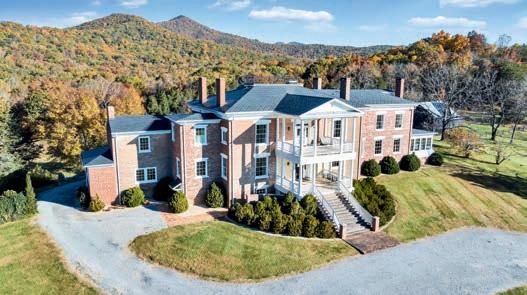







(March 21 – April 19)
(March 21 – April 19) Xx Xx: Xx) Xx
Gemini (May 21 – June 20)
Decline the deviled eggs.
Just as genius requires a touch of madness, passion requires a touch of grace. When Mercury enters your sign on April 16, don’t be surprised to find yourself in an argument sparked by your own bluntness. On that note, this month is a good time to deepen your meditation practice. Don’t have one? Try listening to the sound of water, taking a cold shower, or candle-gazing. At month’s end, Venus in Aries amplifies your natural urge to take initiative in pursuits of the heart. Remember, sometimes the poison becomes the medicine.
Cancer (June 21 – July 22)
Tea leaf “fortunes”
Let your eyes do the talking.
Leo (July 23 – August 22)
Taurus (April 20 – May 20)
Sign up for the workshop.
Two words: mud mask.
Virgo (August 23 – September 22)
Gemini (May 21 – June 20)
Relax the muscles in your face.
Decline the deviled eggs.
Libra (September 23 – October 22)
Cancer (June 21 – July 22)
It’s time for a fresh perspective.

Let your eyes do the talking.
Scorpio (October 23 – November 21)
Leo (July 23 – August 22)
Eat your spinach.
Sign up for the workshop.
Sagittarius (November 22 – December 21)
Virgo (August 23 – September 22)
Go fly a kite.
Relax the muscles in your face.
Capricorn (December 22 – January 19)
Libra (September 23 – October 22)
Keep your bag packed.
It’s time for a fresh perspective.
Aquarius (January 20 – February 18)
Scorpio (October 23 – November 21)
Plant your feet directly on the Earth.
Eat your spinach.
Pisces (February 19 – March 20)
Sagittarius (November 22 – December 21)
Splurge for the one you really want. OH
Go fly a kite.
Capricorn (December 22 – January 19)
Keep your bag packed.
Aquarius (January 20 – February 18)
Plant your feet directly on the Earth.
Pisces (February 19 – March 20)
Splurge for the one you really want. OH





Zora Stellanova has been divining with tea leaves since Game of Thrones’ Starbucks cup mishap of 2019. While she’s not exactly a medium, she’s far from average. She lives in the N.C. foothills with her Sphynx cat, Lyla.








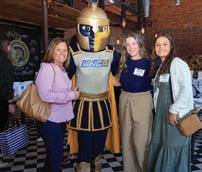
Additional Sponsorships Available Coaches and student-athletes
• Jazz Trio from UNCG School of Music students
LIVE AUCTION HIGHLIGHTS
• Inside the Ropes Experience at the Wyndham Championship
• South African Safari Adventure
• AND MUCH MORE!
SILENT AUCTION with 100+ items!


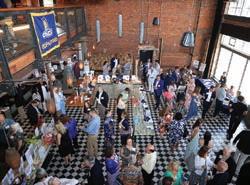









By M aria Johnson




A potty-mouth clean-up is short-bleep-lived

are scary things, the way they learn our habits, which is pretty bleep well.
Why else would my newsfeed recommend that I read a piece in The New York Times titled “Curses! A Swearing Expert Mulls the State of Profanity.”
The story promises tips on how to cut back “if you want to.”
What the bleep does that mean?
I’m talking to you, algorithm, you little son of a software bleep. Are you saying I have a cursing problem?
Well, you’d be partly right.
And partly wrong.
See, most of me is O-bleep -K with cursing. In fact, I love laying down a good oath. There’s a certain catharsis and clarity and energy that comes with damning a bleepity-bleeper to everliving bleep
Bleep. I feel better just typing that.
But another part of me knows I curse out loud too bleep much, though there’s a camaraderie in hanging with other potty mouths. More on that later.
I also curse a lot to myself when I’m fired up about something, which is pretty bleep often. My awareness of this salty leaning has me thinking that maybe I’ll give up cursing for Lent.
How long is Lent?
What?!
Forty days?
Oh, bleep no.
I could maybe do 40 hours.
Like, one work week, from 9 to 5, with nights and weekends off. Sort of a Lent Soft challenge? Is that a sacrilegious question?
Yes?
All right, all right. Forty bleep days. Without spoken-word profanity.
Or swearing in writing.
By m aria JohNsoN
But I get to write using bleeps, and I get to keep the sewer in my head.
Xx Xx
It’s a start. I gotta do something because this habit is getting worse.
Xx OH
Maybe it’s because I’m an empty-nester. I watch my language around children.
Maria Johnson is a contributing editor of O.Henry magazine. Email her at ohenrymaria@gmail.com.
As my grandmother used to say: Little pitchers have big bleep ears.

She didn’t use those exact words, but that’s what she bleep meant.
Because kiddos imitate what they see and hear, my husband and I minded our p’s and q’s — and f’s and s’s — because we didn’t want our sons to blurt out something disrespectful or insulting at the wrong time.

It takes time and maturity to learn how to curse responsibly.
Also, we didn’t want our boys to sound like they were raised in a bleep barn.
Now that our guys don’t live in our bleep barn, I mean house, anymore, I’m not as careful as I used to be. I’ve reverted to my pre-mom setting.
Actually, scratch that.
I’m worse than bleep ever.
Maybe it’s the times we live in.
Have you watched a movie or streamed a TV series lately?
The language is bleep atrocious.
Have you listened to a podcast?
Holy bleep.
Honestly, I don’t like it. But what the bleep am I gonna do? Cancel Max so I can’t watch Hacks any more?
Fat bleep chance. When Season 4 drops, I’m all over that bleep.
Yes, its profane and edgy. It’s also funny as bleep.
So let’s forget about me cutting back on consumption.
I do think there’s room, though, to cut back on my triggers. Namely the news.
Don’t get me wrong; I’m a newshound from the word “go.”
We need to pay attention to what’s going on.
But for the last several years, I’ve hardly been able to watch, read or listen to the news without hollering, “I CANNOT BLEEP BELIEVE THIS!”
I realize my venting doesn’t change diddly-bleep.
But I gotta tell ya: It feels pretty bleep good.
I’d like to clear up one misconception right here: that people who curse a lot don’t have a very good vocabulary.
That’s a load of bleep. I’m not saying that stupid bleeps don’t cuss. But not everyone who cusses is a stupid bleep.
To wit, I do the Spelling Bee every day.
And Wordle.
And a crossword puzzle.
That’s a lot of bleep five-dollar words.
Plus, I’ve been around writers most of my life, and writers are some of the finest cussers I know. We have the verbal palette; many of us just favor the blue hues.
What the bleep?
Maybe this Times story can explain. Where are my bleep glasses?
Oh, here they are.
Let’s see. Looks like they interviewed a guy named Timothy Jay, who’s a retired professor of linguistics at the Massachusetts College of Liberal Arts.
Get this bleep: His specialty was studying profanity. What a bleep fun job that would be.
Ol‘ Timothy says that cursing is indeed more prevalent because society has gotten way more casual.
He blames social media because you can just about write anything on TikTok or X, the platform formerly bleep known as Twitter.
(Aside: When someone comes up with a better verb than “tweet” for the act of reacting with one’s thumbs, please let me know. I refuse to say: “Gimme a minute to X this.”) .
Anyway, Tim says culture is always evolving and just as soon as a taboo becomes acceptable, people will come up with something even taboo-ier.
Translation: Don’t hold your bleep breath for cursing to go away. He goes on to say that cursing is mostly about conveying intensity of emotion, and not always negative emotion. In some
cases, swearing around others indicates belonging and intimacy.
It’s like saying to someone, “You talk like a bleep sailor, but I love you anyway. Also, I trust you not to record this and play it back for my mom.”
The good professor notes that humans get a measurable physical jolt out of swearing.
Roger that bleep
Finally, he says that the only way to curse less is to practice mindfulness about when you curse and why.
Sigh. That’s what AI said, too, when I asked it.
It said to try practicing meditation and yoga instead of cursing.
That’s a lot of bleep Oms.
And box breathing doesn’t charge my battery like swearing does.
I’m thinking my best course of action is to use more curse word substitutes.
Like dang. Or dog. Or freakin. Or fiddlesticks. That’s an oldie and a goodie.
Yeah.
Fiddle-bleep -sticks.
I like the sound of that. OH
Maria Johnson is a contributing editor of O.Henry magazine. Email her at ohenrymaria@gmail.com.

























By A nne Blythe
If you’re someone who likes to armchair travel through the pages of a good book, Terry Roberts, a native of the North Carolina mountains, has a thriller of a journey for you.
In The Devil Hath a Pleasing Shape, Roberts transports his readers to the luxurious Grove Park Inn, a stately and historic resort in Asheville that serves as the dark yet alluring backdrop for a murder mystery that exposes the tiers of a justice system that doesn’t always treat the wealthy and the poor equally.
The book starts with a bang when a nameless man standing near a tousled bed pulls out a pearl-handled derringer, shoots a naked college girl and leaves her on the thick, soft carpet to die in a pool of her own blood.
We quickly meet Stephen Baird Robbins in his home in Hot Springs, 30 miles downriver from Asheville. He’s a twice-married, once-divorced and once-widowed man who has stood trial twice for murder and been acquitted both times.
It’s October 1924, and Robbins, a retired investigator with a reputation for solving seemingly unsolvable crimes, is living a somewhat relaxed existence in a rental home with Luke, his 3-yearold son whose mother died in childbirth. Life had dealt them some wounds and bruises, but Robbins and his two neighbors were optimistic that together, they could raise Luke to adulthood.
When Robbins received a letter on fancy stationery from Benjamin Loftis, owner of the Grove Park Inn, trying to stir him
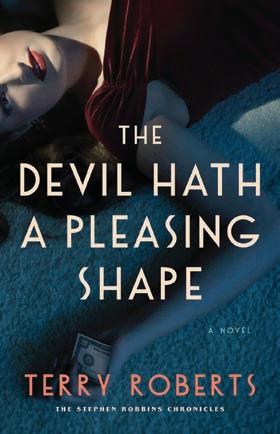
out of his secluded piece of the world, he balled it up and threw it in the fireplace. Loftis persevered, first with a telegram telling Robbins his “presence is required due to a matter of some urgency,” and then with a personal follow-up in a chauffeur-driven trip to Hot Springs.
Loftis, a “newspaperman, chemist, pharmaceutical manufacturer, self-styled architect and — this is important —hotel man,” gave his pitch to Robbins. The hotel’s renown was in jeopardy after a college girl was found dead in one of the plush rooms.
“So in sum, you have a murder on your hands, and not just any murder, but the worst kind — a supposedly innocent young woman,” Robbins responds to Loftin. “The publicity is killing you. Two weeks have gone by and the sheriff hasn’t been able to nail anybody for it and you are getting desperate.” Robbins, a character who has appeared in two previous books by Roberts, let the hotel owner know from the start that he might not like the results.
“I want the murderer caught and punished, so that the inn’s reputation will remain unsullied,” Loftin responds.
Thus begins a tale that takes Robbins, who describes himself as “hill born and runaway” with “rarely two bills in my wallet to rub together,” to a resort where a man of his socioeconomic background is rarely a favored guest. Given wide access to the large granite stone inn described as “the finest pile of rocks ever built,” in October, “when fall began to wrap its cold hands around the
mountains,” Robbins checks into the third floor hotel room next door to the murder scene.
The cast of characters includes an array of hotel workers and well-heeled guests such as judges, politicians and other townspeople who want to mingle and be seen among the wealthy travelers seeking retreat.
The hotel workers, its dining room servers, front desk managers and dutiful housekeepers are an interesting lot. The hotel itself, with all its corridors, luxurious amenities and nooks and crannies, becomes its own character.
Then there are the “girls” — the young women brought in to “keep the party lively” for events that might draw mostly men and a few bored wives. Robbins, a tenacious investigator with a knack for building rapport with the working people, has no qualms about standing up to the powerful. He is determined to find out who killed Rosalind Caldwell, or “Rosie,” as the locals called the young woman found dead in the hotel.
“Perhaps only Stephen Robbins could do what must be done here,” Roberts writes in his acknowledgements thanking the character for yet another appearance in one of his books.
“After all, this is a book about prostitution and politics — a timely topic — and it required a hard hand and true voice to find justice.”

The Devil Hath a Pleasing Shape is about social status, privilege, racial injustices a wrongful arrest and a forthright observation that things are not always as they seem, even if that’s what the wider community wants you to believe. In fast-moving, descriptive prose, Roberts takes readers on a pursuit filled with danger and love that reveals the deaths of two other young women found lifeless in circumstances eerily similar to Rosie’s.
These were not the sort of women whose deaths would typically draw big headlines in Prohibition Era Asheville, Robbins notes. Their bodies were not discovered in a fancy hotel, nor did they come from the well-to-do neighborhoods of the town’s rich and famous.
Even if there are enough clues to figure out the likely killer long before the story ends, Roberts is adept at pulling his readers through to the conclusion to find out whether or not there will be justice for these victims. It’s an entertaining pursuit, a journey to another place and another time well worth taking. OH
Anne Blythe has been a reporter in North Carolina for more than three decades covering city halls, higher education, the courts, crime, hurricanes, ice storms, droughts, floods, college sports, health care and many wonderful characters who make this state such an interesting place.












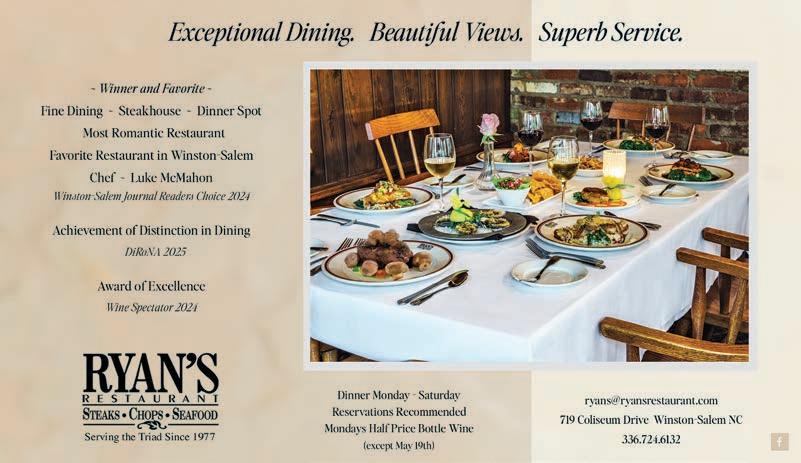


By Cynthi A A dA ms
My friend, Pratt, is laid up with woes: a serious illness that has taken a number of medical tests to diagnose and more pain pills than he cares to swallow.
But this week just takes the cake, he tells me. A favorite Toby jug slipped from his hands and shattered. His microwave won’t cook beyond seven minutes before halting. “Is it protesting, or just broken?” I ask. I suggested what my tech-savvy husband always tells me: power off and restart.
Then his smart TV died.
“I’m reduced to using my old, stupid TV,” he mutters.
From my experience, smart TVs are just as stupid.
Ours regularly seems to freeze up — much like I used to do before a Toastmaster’s speech. It goes into sputtering spasms mid-streaming, just before the second to last episode of a compelling Netflix drama.
Our so-called smart TV doesn’t especially like being told what to do by Roku and regularly strikes until rebooting.
Rebooting heretofore sounded like something you’d have a cobbler do, versus a tech fix.
Sadly, even if my TV is getting smarter, I am not. The mechanisms of technology mystify me as much as ever. When my bank’s online bill-paying function abruptly stopped working this past weekend, I developed hives, fearing I’d been hacked.
Nope.
The banking IT pros were the guilty party behind this sabotage, all due to an update. Post said improvement, nothing
functioned properly for days. Trying to resolve this over the phone — during which I was asked such things as “have you cleared your cache?” — I shuddered and felt mildly sick.
Actually, no, I had not even touched my cache.
“What about your VPN?” Before I embarrassed myself by blurting out something about my VCR (long ago consigned to recycling), I answered honestly. “VP what?”
The customer service representative sighed. “Try logging in via a search engine other than your usual.” Flustered and fumbling as she stayed on the phone with me, I faced another hurdle. I could not read my own scribbled passwords.
My head throbbed. Meantime, Citibank hit me with a $28 late fee for a balance of $18 I couldn’t manage logging on to pay.
By day five of this technological marathon, I had a low-tech solution. Maybe I'd move elsewhere. But I was soon notified of a national data breach. My response? To freeze my credit and change all auto payments, and google distant archipelagos where no one uses the word “breach.”
My cell phone immediately began doing a curious thing, cutting out calls as quickly as I could answer them, perversely trying to connect to my headphones each time.
I took the same advice I’d rattled off to Pratt and gave it the ol’ power off and reboot.
It worked!
Seems you don’t have to have the smarts to hold the power. But before I clear my cache, I’m doing a juice fast, pulling olive oil and visual meditation.
Then I’m powering my entire self completely down. OH
Cynthia Adam is a contributing editor to O.Henry magazine.
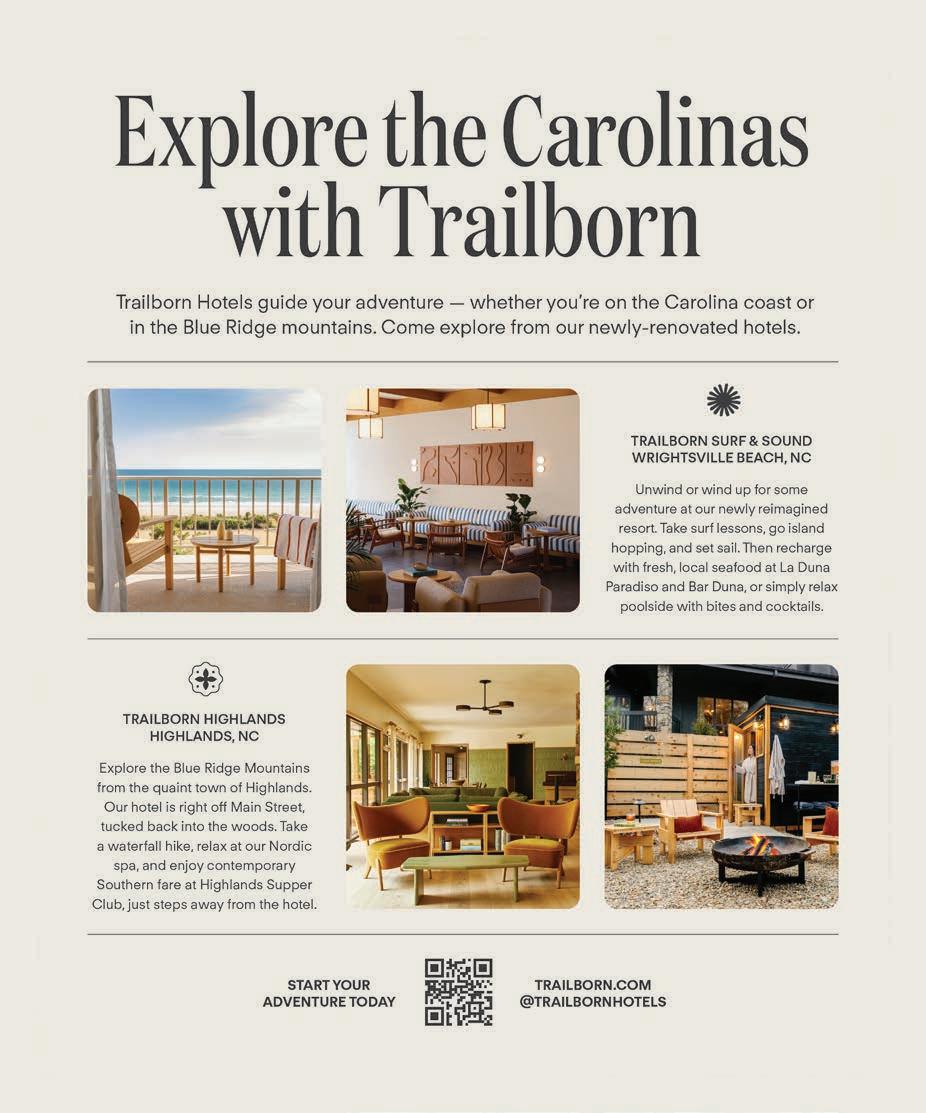

By eriC sCh Aefer
An oriole sings to me from the top of a hickory, and I rush to put out orange slices and pots of grape jelly. But he won’t stay. Every spring, he flies off as if he has some important place to go. "Stay a while,” I say. “There is no hurry.” But he’s off to an unknown destination. I can’t stay much longer either.
We bought the place because of the lake. The house was a wreck. We hauled out a dozen soiled mattresses, a pickup load of beer cans and various detritus. The work was hard, but there was always the lake. We took lots of breaks to lounge and try to find the cool places where the springs came up from the bottom. One day, an engineer from the state came around and inspected the dam. He said the trees on the back side of the dam should not have been allowed to grow up. Their roots would undermine the dam’s integrity, but cutting them down now might be worse because rotting roots were more dangerous. Telling us what should have happened before we arrived was not helpful, but he was right. The dam grew weaker and more vulnerable each year but held on until the remnants of a hurricane backed up water, and it gave up in a sudden, catastrophic collapse. Three acres of water, fish, turtles and flotsam went downstream overnight. In the morning, there was nothing but mud.
Since fixing the dam was prohibitively expensive, we were forced to watch nature reclaim the land. Initially, it was depressing, but nature didn’t waste time providing us with a show. Grasses and shrubs were quick to sprout, and it wasn’t long
before willows, sycamores and sweet gums covered the old lake bed. We traded kingfishers and hooded mergansers for common yellow throats and a chat or two who liked the new growth. Then, one morning, walking the stream that runs down the middle of the old lake bed, I came across a stick that had been stripped of its bark.
Beavers are often considered a nuisance, but, in my old lake bed, they were welcome. It took them just a few days to construct their first dam. While working, they lived in a burrow in the stream bank and came out to work crepuscularly. I thought their first dam should have been located further downstream, but my wife said, “Don’t argue with the engineers. They’ve been doing this for a long time.”
She’s right. Castor canadensis has been shaping the landscape for 7 million years or so. They not only build dams and lodges, but, once water backs up enough, they dredge channels in their new pond so they can swim deep enough to keep out of reach of predators. When they cut down a tree that is too big to drag, they either cut it up or make a canal to float the wood to where they want it.
I wanted to watch the endeavor, so I started going down to the stream early in the morning and evening. The first animal I encountered slapped his tail on the water hard enough to sound like a gunshot, making me nearly jump out of my boots. But I knew the pond wasn’t big enough for him to hide for long, so I sat down to wait. Sure enough, he stuck his nose out of the water in a minute or two. He lay motionless with just his nose above water, looking me over until he decided I wasn’t a threat, and then he glided across his pond to where there was a freshly cut willow branch. He sat on his haunches in the shallow water, held the stick
There’s no one-size-fits-all path to success. UNCG’s flexible class schedules and top ranked online programs allow Spartans to break salary caps and find careers they love.
Watch them become changemakers for their families and fuel the future of our North Carolina communities. It’s all within reach at UNCG.
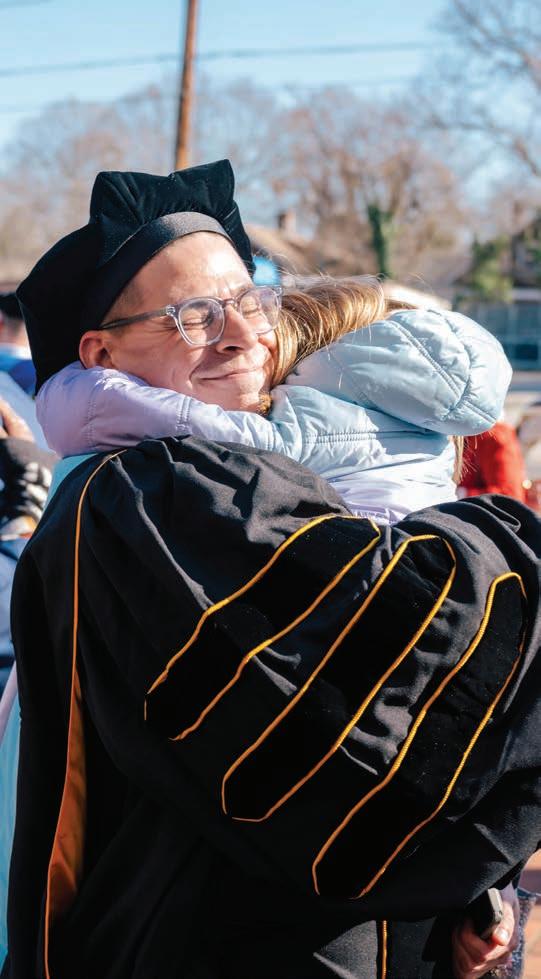
in his front paws and started eating the bark off the stick like you would eat corn on the cob.
I began to visit him regularly in the evening. Sometimes, I’d bring a snack and eat with him. He never gave that warning tail slap again. He’d pause when I’d arrive — I fancy he was making sure it was only me — then he’d go about his business, unperturbed. Sometimes, a more petite beaver, perhaps his girlfriend, would show up. They built an impressive mound of sticks on the pond's bank, and I could imagine its cozy interior, where I hoped they would be raising kits in the winter. Beavers are laid back about their accommodations. They have been known to share their lodge with otters, muskrats and other wetland neighbors. If I had been smaller and a little younger, I might have tried to visit them in their home.
Tragedy struck one day in the form of another storm that raised the water enough to wash away the beaver lodge and completely destroy their dam. I don’t know where they ended up; I haven’t seen them again. The lake bed is now filled with willow stabs and brambles. They didn’t like the sycamores much and left them pretty much alone, so the area has taken a new turn. I’d like to watch and see what develops, but my wife and I can’t take care of the place anymore. Can’t keep the house from falling down or the yard from turning into a jungle. We can’t keep enough wood to keep the fire going. We’ll be moving on soon. I know not where, but there will be a different assortment of birds, perhaps an unfamiliar flowering shrub might catch my eye, or a butterfly new to me will land on the bench where I’ve come to sit and watch. I might even land where the oriole makes his home. OH
Eric Schaefer, and his wife, Janet, a French teacher and accomplished artist, have lived on a few acres north of Greensboro for 40 years, where they’ve kept all sorts of animals from sheep to chickens. Though he holds his master’s degree from UNCG in biology, he has always enjoyed writing and, for many years, penned a Sunday News & Record column on outdoor activities.

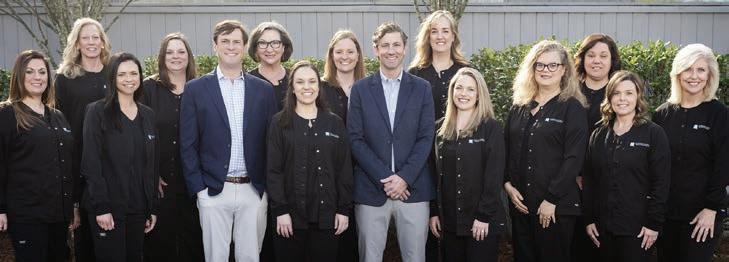







At Doctors Hearing Care, better hearing is always our focus. Dr. Amy Kirkland, Au.D. and Dr. Melissa Westall, Au.D. are committed to provide each patient with an exceptional level of care and attention. Together, they have been the triad’s leaders in hearing technology for over 28 years.



• Lucky 32: Lunch & Dinner 6 DAYS (Closed Mon.) (BRUNCH Sat. & Sun.)
• O.Henry LIVE JAZZ! Every Thursday from 6-9 PM and Select Saturdays from 7-10 PM in the Social Lobby. See the schedule at ohenryhotel.com
• LIVE Music at Lucky 32! AM rOdeO (Jessica Mashburn & Evan Olson) 6-9 PM lucky32.com
• Romance, Jazz, and Symphony Packages at O.Henry & Proximity Book online at ohenryhotel.com or proximityhotel.com
• Artist-in-Residence Chip Holton at L32! Live painting Wednesday – Sunday 12-2 PM and 6-8 PM. Stop by!! lucky32.com
• Weddings | Meetings | Retreats | Events | Group Accommodations Learn more ohenryhotel.com or proximityhotel.com
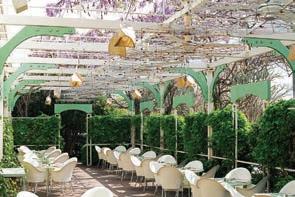
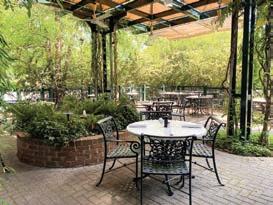

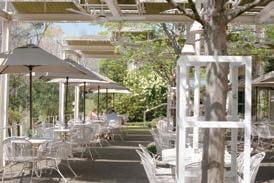

By susA n CA mpBell
In early spring, birdwatchers such as myself are eager to spot the first returning migrants of the season. These are northbound birds that have spent the cooler months far to our south, in Central or South America. There, the living is easy, with plentiful food and a mild climate. But as the days begin to lengthen, these birds begin their return flight to the breeding grounds. Many may fly both day and night as the urgency of their mission increases. Hormone levels drive them to make their way swiftly to their natal area. Some return to the exact patch of woods, marsh or lake where they themselves hatched.
One of the earliest to return here in central North Carolina is the Louisiana waterthrush. A small, drab warbler, it is far more likely to be heard than seen at first. Its plumage is streaky brown and white. Birds can be recognized by their prominent broad white eyebrows and pink legs. As its name implies, the species prefers wet habitat, being at home along streams and rivers where it not only feeds in the trees, but along banks and around rocks at the water’s edge.
In the spring, Louisiana waterthrushes will call or sing as they move from place to place. As with so many species, the male’s
vocalizing serves not only to attract a mate, but to establish territory. They have a loud, melodic song that carries well over the sound of moving water. The species’ call note, too, is a high volume “chip” that is easy to pick up in thick vegetation or above a gurgling stream.
Louisiana waterthrushes are insectivorous and so will consume any fly, midge or beetle that it sees. Also, waterthrushes will pick hatching aquatic insects such as mayflies or stoneflies out of the water. Individuals may wade in the shallows as they forage, making short jabs at potential prey items.
After pairs find one another and begin to raise the next generation of waterthrushes, they become virtually silent. This no doubt enables them to protect their nesting site and their young from would-be predators. Nests are built on or near the ground, making them relatively vulnerable to disturbance. Secretive behavior also reduces the chances that they will be parasitized by brown-headed cowbirds, which are known to seek out open cup nests such as those made by waterthrushes to deposit a single egg. The resulting nestling will be unwittingly cared for by waterthrush parents to the detriment of their own young.
Being one of the earliest warblers to return in the early spring, they are also likely to disperse in early summer after their young leave the nest. They may return to their Central American wintering grounds by the end of July. If you are fortunate enough to encounter a Louisiana waterthrush in the weeks to come, enjoy it because it is not likely to be around for very long OH
Susan Campbell would love to hear from you if you have interesting bird observations to share. Contact her at susan@ncaves.com




For over 30 years, Ron C. Curlee II has stretched his artistic limits
By Billy ingr A m
“All great
change in America begins at the dinner table.”
—
Ronald Reagan
In 1994, Ron C. Curlee II was the first intriguingly talented individual I met in our fair city after relocating mere days before from Los Angeles. I’d wandered into Babylon, an infamous rave club located on South Elm in the long-dead heart of downtown Greensboro. Babylon was notorious for shoveling underaged kids through its doors. For all I knew, Ron may have fallen into that category.
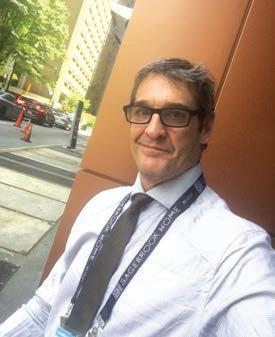
As it happens, that den of iniquity was sponsoring an art opening of Ron’s Crimes Against Nature series — enormous canvases featuring, for the era, bold, lurid and graphic imagery of exactly what the work’s title suggests. We instantly hit it off and, since then, it has always been a pleasure in those too rare instances when our divergent paths cross; laughter is always sure to follow, sparked by his gregarious personality, somehow both serious and fun.
I marvel that today Ron remains on the cutting edge, a key component of his career being his three decades participating in the High Point Market as a painter of extraordinarily original abstracts, as well as a designer and merchandiser.
Accomplished in both art and design, his career has had an internal reach. In addition to dozens of local shows and commissions, his artwork has been featured in most of the well-known furniture showrooms, including Highland House, Harden, Francesco Molon, Excelsior, Century, Hickory Hill and Drexel Heritage.
This area has grown significantly since the mid-1990s, when
the impact that Market made all across the Triad was seismic. Families back then were renting out their homes to attendees for $1,500 a week, due to lack of available hotel rooms. Venturing out to dinner, even in Greensboro, became a challenge during those two-week periods, the nicer restaurants being predictably overbooked. On those occasions when I would dine out with my parents during April and October Market, generally at some out-of-the-way steakhouse such as Jordan’s on Church Street, we’d amuse ourselves by observing nearby tables where sales reps were expense accounting the night away with obvious ladies of the evening who flocked from near and far to service this influx of out-of-towners.
Ron grew up in Lenoir and attended the University of Georgia’s studies abroad program, where he studied painting in Italy. But it was actually the lure of the Market that brought him to Greensboro in the 1990s. I recently caught up with him in his richly appointed, downtown Greensboro home-studio duplex (thestudioandgallery.square.site) to look back on some of his more colorful experiences at High Point Market.
Following the death of Diana, Princess of Wales, Paul Burrell, her former butler and one-time footman for Queen Elizabeth II, began licensing his name for various upscale goods that included furniture. “I was director of visual merchandising for an upholstery company that paid to use Burrell’s name,” Ron tells me. “So we made up all the stories behind his collection that was [supposedly] based on his travels with Princess Diana.”
This was following the “uppity” butler’s trial for stealing various personal items from the beloved Princess and after Prince Harry publicly accused him of “milking” his mother’s death in Burrell’s scandalous book, A Royal Duty. “I traveled around England with him,” Ron recalls. “People either loved


him because they wanted to know about Princess Diana or they despised him because he had risen above his station. So it was very awkward.” At gallery openings and tea parties, Burrell would regale audiences with stories about how Diana’s boys would sit on chairs like the one on display or the way Princess Diana would relax on a sofa resembling that model. “And we wrote all of that for him.”
On one occasion, while imbibing a bit heavily on a rather empty stomach, Ron recalls, “I may have told [Burrell] that he was just the front man who didn't know anything, that I was doing everything while he was getting all the credit.” The next morning, he says, “They told me Paul didn't have anything to say and just up and left.” Not long after, Ron got wind that Burrell was talking with a friend in New York who was getting him drunk and secretly recording their conversation about the Queen and Princess Margaret, then selling it to a tabloid for a million dollars. “And I was like, why didn't I
Ron has also rubbed elbows with Hollywood royalty and recalls a furniture collection introduced at Market that he thought was immediately fabulous and very successful. “The Humphrey Bogart Collection from Thomasville,” he replies. “I have pieces from that line in my living room. It was like Old Hollywood, a little deco with lots of unique woods, veneers and different applications. A mixture of skins and veneers like shagreen shark skin, tiger-eye maple, zebra wood.” Bogart and Lauren Bacall’s son, Stephen, had input into the designs and made an appearance in 2002 at the presentation party.
Was there a ruinous collection he was saddled with showcasing that was an absolute disaster? “At Fine Furniture Design, they’re no longer in the United States,” Ron says with a laugh. “They were high end and introduced a collection that was entirely covered in mirrors. They had a mirrored poster bed, entertainment cabinet, occasional end tables, cocktail tables and a dining table that sat 12.” Ron was flabbergasted. “I was just like, what the
hell is this? It was so ostentatious, so over the top and it didn’t sell.” Upon reflection, the manufacturer blamed Ron for the line’s failure. “I was told that I didn't paint the rooms the right color, I didn’t do the right presentation. I was thinking, my accessories should have been razor blades and straws!”
Collections are generally only offered for a year or so and then quietly disappear. “They can last longer but Market is fashion driven,” Ron points out. “Everybody wants something new. So you may add a few pieces and continue a collection for a couple seasons, maybe a year and a half or two years. But you want to be fashion forward.” To that end, designers tend to lean into Pantone's Color of the Year — in 2025, it’s Mocha Mouse. “So buyers are looking at mocha fabrics; yarns will be dyed that, too. Last year it was Peach Fuzz.”
Both during and outside of Market, folks generally approach Ron when they’re looking for artwork to complete a room. “I’m known for large abstracts, so I can build up to 10 feet by 10 feet,” he says. “At Market, they're not going to offer something custom. It’s going to be what's on the wall and buyers will order 10 of them or whatever. But all of my creations are going to be original and custom.”
For the next few weeks, it’s once more into the breach for Ron C. Curlee II: “So I’ll merchandise several showrooms and then, when they're completed, I head to the Suites at Market Square and put my own showroom together to sell my artwork.” He’s been showing at Market Square for about four years now. “Sometimes I have other artists or product designers in my space but I’m not going to sell a container full of merchandise. A lot of my clients are designers, so they’ll come to market, see what I have and what I’ve done and then commission artwork in specific sizes, specific colors. Seeing me at Market is a reminder that I’m still here.” OH
Like his father and grandfather before him, Billy Ingram is the third generation to own a business — TV Party — in downtown Greensboro.

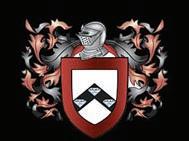




Anyone interested in learning more or participating may contact our Director of Development, Joy Truluck, at giving@senior-resources-guilford.org or by calling 336-272-4816 ext 258. For every $15 donation, we’ll mail a Mother’s Day card on the donor’s behalf.


Fax: 336-883-3179
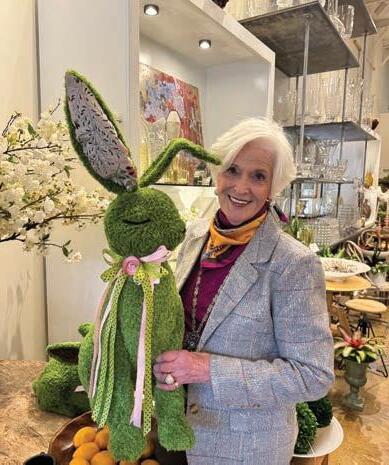

The catbird is pecking away at two ripe tomatoes. I wave my hands and shout, My tomatoes! as though I’d produced them from my breasts or belly.
The catbird aerializes on the tomato cage, jabbing and jabbing the red fruit. I have more on the counter that I won’t eat before they rot, or that I’ll give away.
It’s unseemly, this stinginess, a memory of not-enough, the necessity of preserving a crop from rabbits and deer, the otherwise marvelous round-backed bugs, grasshoppers flaring red underwings,
or birds like this one, gray as a civil servant, an actuary of ripeness, that tilts its head to eye the fruit and flaunts its rusty bottom in salute.
— Valerie Nieman
Valerie Nieman’s latest book, Upon the Corner of the Moon: A Tale of the Macbeths, was released in March.

By Cassie Bustamante
PhotograPhs By John gessner
“For me, it’s always been just to have the lightest impact on the world, on nature,” says Ann Tilley as she peers out from her sewing studio’s garage door, surveying the acreage that surrounds it. Nearby sits the narrow, tiny house with wood siding she and her husband, musician Adam Joyce, built and now reside in. The large family property is just about as far southeast as you can get in Guilford County. Just behind their home, a row of raised garden beds made from old refrigerators host early spring plantings, such as garlic, protected from the couple’s curious cats. Clothing pinned on a line strung along the garden’s exterior border waves in the breeze.
Tilley pauses, her fingers gently gliding along a patchwork T-shirt in shades of green with touches of lilac. “This is my absolute favorite shirt.” The garment has been created by stitching together pieces from old band merch. And not just any band — The Bronzed Chorus, Joyce’s group, whose sound is, according to Tilley, “instrumental post-rock, but then there’s a lot of synthesizer and electronic. I always

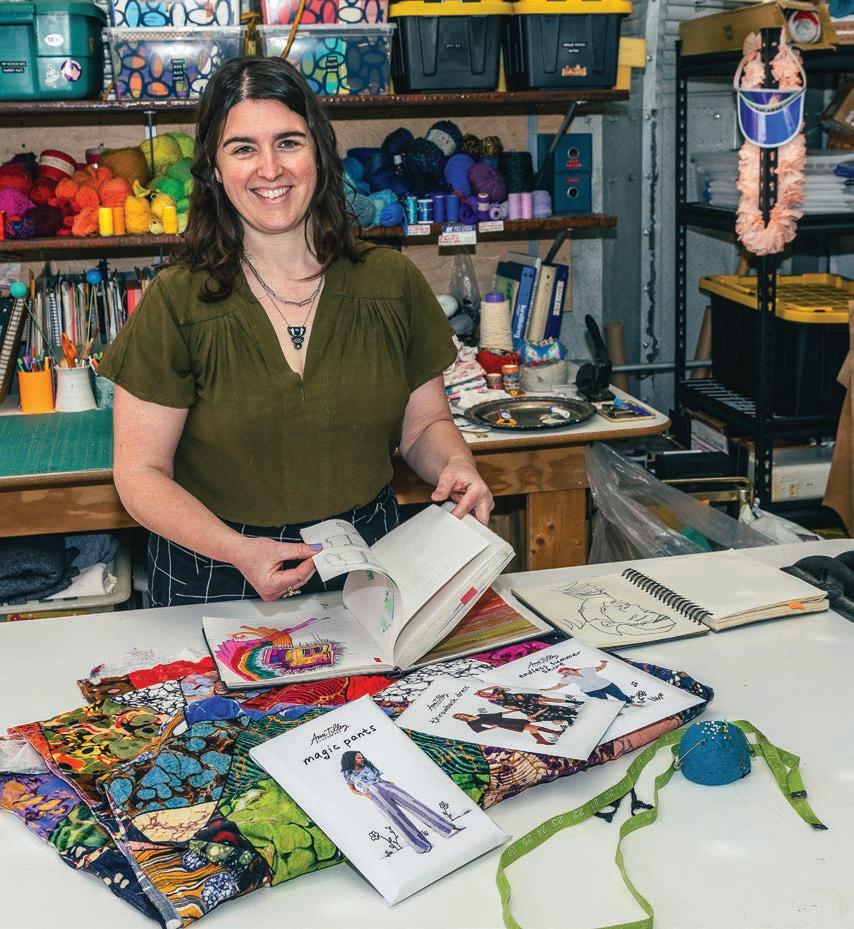
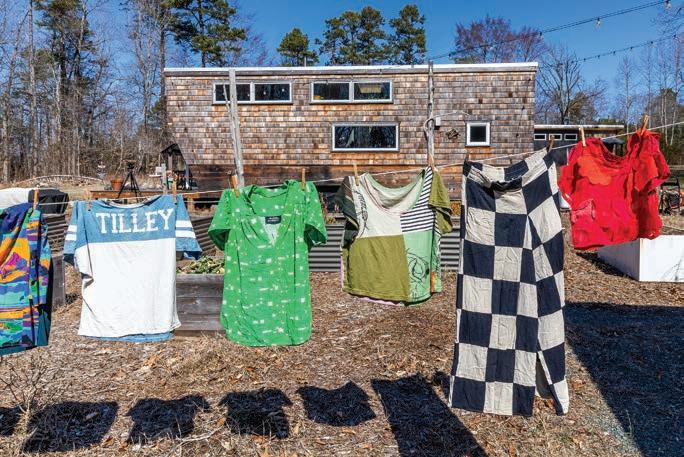
say that if you listen to it in your car, you want to speed.” Tilley made a dozen or so of these tees and sold them at the band’s shows. The couple originally met at a Bronzed Chorus show in Durham, where Tilley was raised. Today, both are employees of Forge Greensboro. Joyce, a woodworker and furniture maker by trade, runs the makerspace’s wood shop while Tilley runs the textile shop.
Back in Bull City, Tilley’s parents own and run Acme Plumbing Company, originally founded by her great-grandfather. While her mother owned a sewing machine, Tilley, now 38, says the actual use of it sort of skipped a generation. “It was not progressive for her to sew,” she muses. Instead of traditional toys, Mom bought the kids sketchbooks and markers, nurturing creativity in other ways, while at the same time instilling in them environmentally conscious values.
“My mom was the first person I ever knew who wouldn’t buy something because of the packaging associated with it — before I ever heard of zero waste,” says Tilley.
Tilley recalls latching onto cross stitch as a child via Girl Scouts, discovering she loved fabricating art from fibers and how embroidery floss felt on her fingers. Later, in her tween years, a household book she happened to pull from a shelf opened her up to the world of sewing.
Foot to the pedal, she unearthed a means to express herself. “I like to be different,” she says. “I don’t like to wear what other people wear.”
Still, as the child of practical, no-nonsense parents, she says, “I thought fashion was frivolous. My parents are plumbers.”
Tilley’s interest in the arts led her to the Savannah College of Art and Design, a move that she says was good for her be -
cause it allowed her to explore painting, drawing, illustration and fashion. By the time she was an upperclassman, “I was obsessed with fashion magazines,” she recalls. “Harper’s Bazaar was my bible!” Tilley would flip through pages and, inspired, make her own versions of what she saw.
Her fashion interests led her to discover the fibers department, something she didn’t even know had a name. She recalls someone explaining to her what that department entailed and realizing it was exactly what she’d been after — “That’s me!” she recalls exclaiming. In 2008, Tilley graduated with her Bachelor of Fine Arts in fashion and fibers.
These days, Tilley calls herself a textile artist. The light-wood walls of her tiny home are filled with her own creations. “Pop art was my first love, which I think is really obvious.”
The art that hangs on her walls makes the house into something of a tiny museum that catalogues Tilley’s evolving interest in textiles. Inside a large, charcoal-gray, curved frame mimicking the shape of an iPhone is a woven textile she calls Hold Me, which is exactly what the text on the piece beckons. On the adjacent wall in the tiny home’s single spiral staircase leading to the loft, a complementary creation titled Current Reflections is framed in wood salvaged from old bleachers and given to them by a Forge friend. The piece itself is a chartreuse green, the yarn dyed by Tilley, and features a motif of toothbrushes, solar panels, poison ivy, trees and, in the center, tiny homes.
Up in the loft, the couple’s platform bed sits below a skylight. A shelf, inches away from the foot of the bed and made from the same recycled bleacher wood, provides ample room for books, plus space for guitar cases below. “It’s a little bit of a pain in the ass to change the sheets, but . . . ,” she trails off dreamily, looking up.
“I can literally see the Big Dipper,” she says. “And when you wake up in the middle of the night and the moon is there, I feel blessed every time.”
Next to the bed, a wall hanging Tilly fabricated faces the wrong direction so that the couple’s brindle-coated kitten, Tina — short for Patina — won’t damage it. Tilley takes it down and Tina immediately attacks.
The hanging is one of several Tilley made during a three-
week art residency at Reconsidered Goods last November. Using denim yardage unearthed in “a ’70s storage unit,” Tilley crafted a piece that pays homage to Greensboro’s history in garment making, as well as her own background working as a Wrangler traveling on-site tailor and at a Raleigh denim factory. A pocket on the hanging is adorned with a leather Wrangler patch and Ralph Lauren rivets, a spray of bright, printed and embellished flowers emerging. Hot-pink felt lettering reads “Feeling lost? Discover crafts.”
“All of these pieces came from the idea of craft as therapy,” says Tilley of the work that came out of her residency.
Back downstairs on a gallery wall, a hanging fabricated from necktie silk reads “Days for Making, Days for Mending,” a necktie Tilley sewed hanging down its center. Along the bottom of the piece, “Salem” tags create a sort of fringe effect. Last fall, Tilley toured Salem Neckwear with Rene Trogdon, who was selling off and donating machinery and materials. His late father, James Trogdon Sr., had founded the company in 1964 to fill a niche market for premium neckties. Sixty years later, after Rene’s brother and the company’s then-president, James Trogdon Jr., became ill with long COVID, Rene found himself in a tough position and had to close. Sadly, James Trogdon Jr. passed away in December of last year.
“I mourn those stories of the loss of small and local,” she says, noting her parents’ own multigenerational company. Creating art
with remnants from businesses such as Salem Neckwear, she gets to preserve a piece of their story.
“The thing I fear the most,” she continues, “is just that globalization is taking away all of that local personality.”
Every corner of their house, almost every nook and cranny in it, veers away from mass merchandising and designs driven by bigbox retailers such as HomeGoods and Home Depot. The sliding door that leads to their single, green-tiled bathroom is a remnant from Tilley’s childhood bedroom. Where the original hardware sat, Joyce created darker-stained, midcentury-inspired wood inlays that flank the new nickel hardware. The exterior panels have been covered with mirrors to reflect light, giving the illusion of space. But the interior of the door was not such an easy task.
Tilley struggled to strip all of the paint and eventually settled on covering it with a pastoral mural.
“I thought it was going to be done in a year without me doing anything,” quips Tilley about the home’s construction. But, she soon realized, “we need to do this together.”
Over the course of almost a decade, whenever they had time, Tilley and Joyce could be found outside of their rental home, just down the road in Julian, measuring, cutting, hammering. They also regularly visited the property, which had been in Joyce’s family for generations, first building and installing a solar shed.
The doors to the shed feature a modern graphic design in vibrant colors, inspired by a Frank Stella piece. Stella, who passed


away in May of last year, was known as one of the fathers of 1960s minimalist art. Tilley and Joyce painted the doors right after a particularly busy moment in life, “and then, on our week off, we were like, ‘Let’s do something fun.’” A moment later, she chuckles. “We can’t ever relax.”
Beyond its bold doors, the building houses the tiny home’s breaker box and a generator, plus the regular tools one would expect to find in a shed. As far as the solar system that runs the property’s power, Tilley says, “Adam just watched a bunch of YouTube videos” and figured it out.
Some yards away from the home, a curved hangar featuring a bold, turquoise garage door serves as her sewing studio. It’s not heated though, so she has plans to construct a new building and has marked stairs with old sewing machines leading to where it will exist a stone’s throw away. “Manifest destiny, you know?”
“Right now, it’s a little nippy,” Tilley says. She tugs tighter around her a lavender velvet jacket she made with a cherry-printed lining, all fabric sourced from Reconsidered Goods.
This is where the real “magic” Tilley is known for happens — Magic Pants, that is. In 2016, Tilley founded Ann & Anne, a ready-to-wear clothing brand, with Anne Schroth, owner of Red Canary. While there, the two women designed a high-waisted tailored pant that featured an invisible elastic band in the back, an elastic panel in the front, and a cinching strap. The result? A pant that flattered figures of all shapes and sizes. Her friends started calling them “Magic Pants” and the name stuck.
Ann & Anne closed officially in 2018 and Tilley pivoted to teaching sewing classes across the area, from Durham all the way
to Winston-Salem, including a stint at the John C. Campbell Folk School in Brasstown.
At Village Fabric Shop in Winston-Salem, she offered a class on making Magic Pants and the shop employees suggested that she make a pattern for them. At the time, she was busy teaching, but when COVID shut that down for a while, she got to work. And now? “I have literally sold this [pattern] on six continents.”
Tilley has also created her own YouTube channel, which allows her to increase her reach, teaching people across the world how to make these pants. Sewing, she says, is what gave her the “first feelings of self-sufficiency,” something she hopes to pass on to others through her instruction. Nowadays, she makes practically everything she wears, right down to the undies, something she started making from scraps when she worked at Gaia Conceptions, a sustainable brand founded by Andrea Crouse and located “just behind Westerwood Tavern.”
“I worked there for years,” says Tilley. Gaia Conceptions, she says, features made-to-order organic clothing and the brand pays its employees fairly. “They really walk the walk.” Crouse, Tilley says, even showed her how to make her own deodorant.
Nearby, a pair of of underwear in blue and white sits on her sewing table. “I haven’t worn these — don’t worry” she quips. The fabric is soft, comfortable, and there’s no elastic that would dig into a waist.
While the temperatures have been less than ideal, Tilley has, for now, set up shop in Joyce’s music studio, settled a little farther back on their land. A makeshift desk in the middle of his space holds her Brother sewing machine, a row of guitars




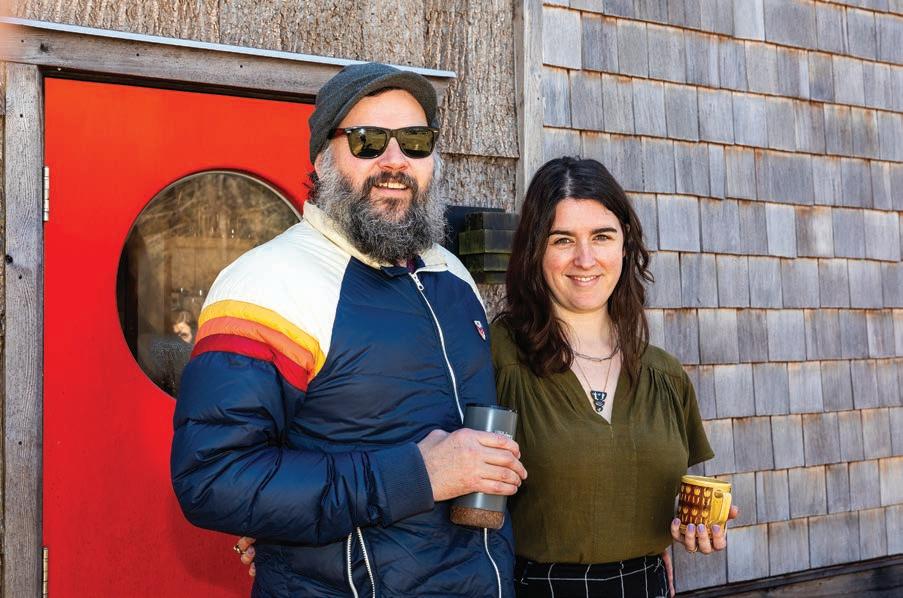
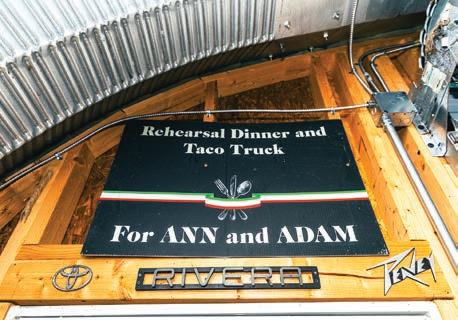
hanging on the wall behind it. Next to the machine, old fashion drawings from her SCAD days feature a flirty midi dress, a long embellished gown and a mod ’60s-inspired swimsuit. “I do make my own swimsuits now,” she says. “And having a well-fitting swimsuit is wild!”
Joyce’s studio serves as the hangout spot for the couple’s other cat, Go-Go Boots, a beauty with long fur everywhere except for — you guessed it — below her knees. With the sun beckoning, she requests to go outside. Tilley follows.
“We actually got married in this field,” she says, looking out into a large, cleared space of land. In July of 2016, the couple tied the knot. True to form, the large tent that provided shade for guests was made by a friend “from old Tyvek he dumpster dived.”
And do they plan to live out their days where they once said “I do”?
“Forever home, absolutely,” says Tilley. Perhaps, one day, they may consider building a different house with a main-level bedroom as they age. But, if they do, it will be right here. “It’s a way of life.” OH
For more information or to order your own Magic Pants pattern, visit anntilleyhandmade.com.
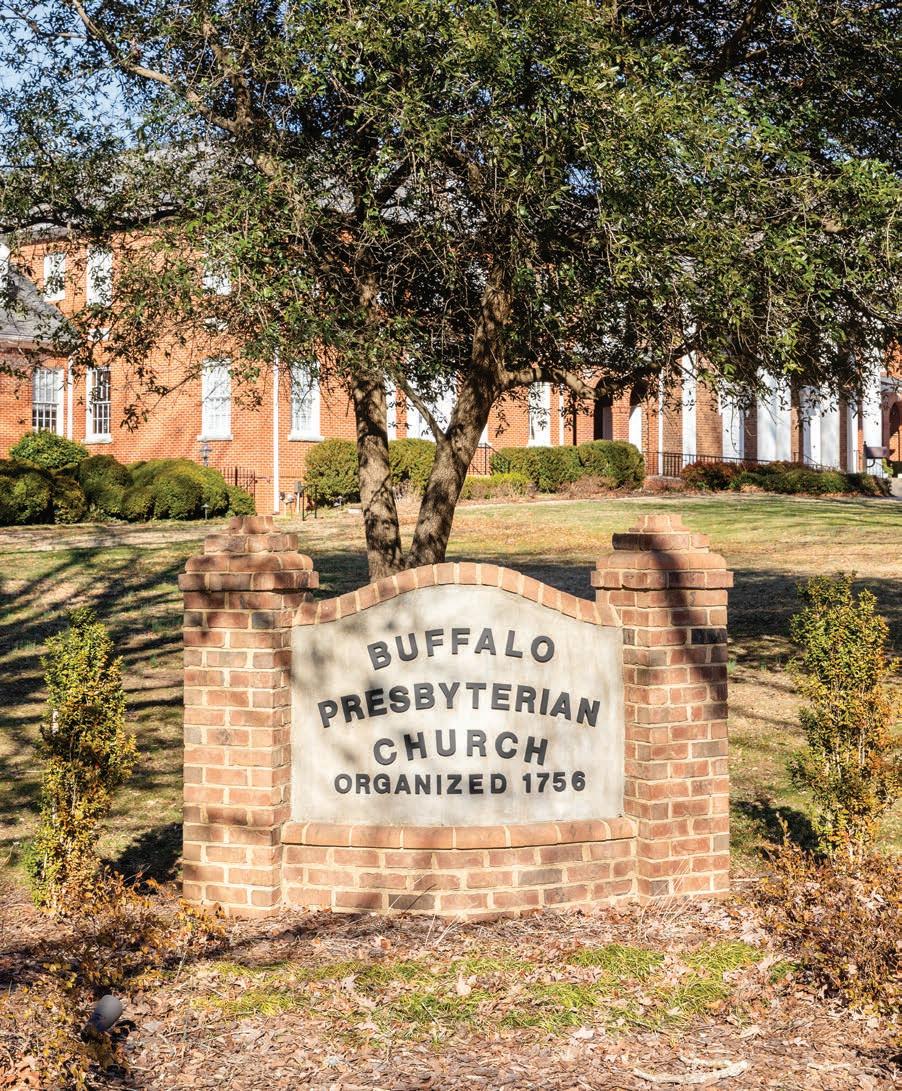
By Jim DoDson • PhotograPhs By John gessner
n a mild winter morning, welcome hints of spring in the air, the pews at historic Buffalo Presbyterian Church are nearly full for a Sunday service celebrating Rev. Brian Marsh’s second anniversary. Remarkably, Marsh is only the 17th minister in 269 years to occupy Buffalo’s pulpit since the church was organized by a band of Scots-Irish settlers in 1756. Such longevity speaks volumes about the faith and continuity of a church that predates the establishment of Guilford County by 15 years, the United States of America by 20 years, and Greensboro itself by 52 years.
“I sometimes have to fight my emotions when I think about Buffalo’s historical importance to this community, a place where
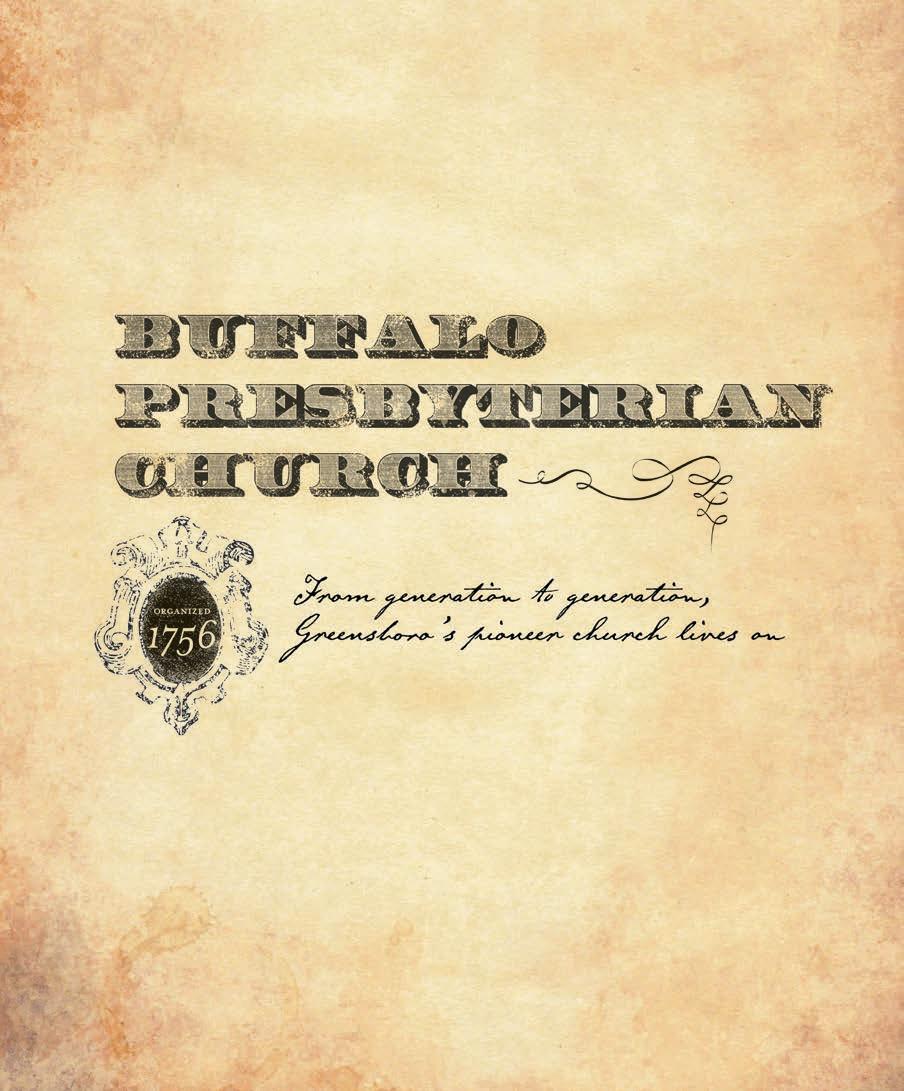
so many families of Greensboro have worshipped for centuries,” says Thomas McKnight, an eighth-generation member whose ancestor wrote the deed for the land on which the church sits.
“Through the ups and downs of its history, good times and bad, literally war and peace, Buffalo Church has been a spiritual home where God’s word is preached and all are welcome.”
“I think that’s been the comforting message of Buffalo Church since its earliest days,” agrees Vinnie Gordy, another eighthgeneration member who was baptized, grew up and was married in the church. “The settlers who created this church came out of a dangerous wilderness to make this their spiritual home. And that’s exactly what Buffalo Church is to many of us today — a
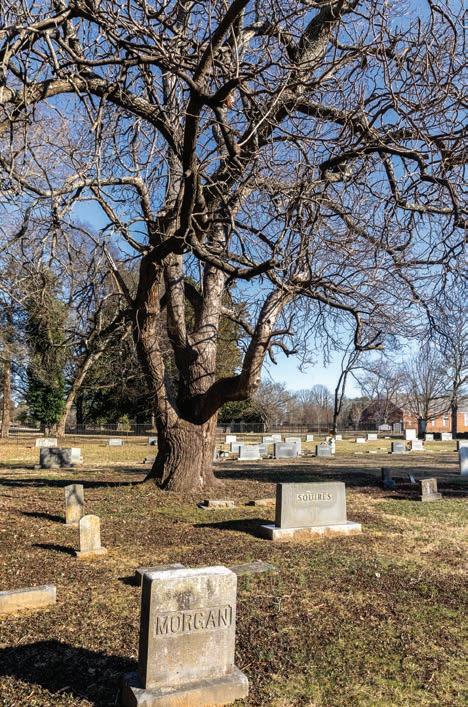
home where we belong, sharing the love of Christ and the word of the Bible.”
Buffalo’s founders were liberty-loving, Scots-Irish immigrants who followed the Great Wagon Road from southern Pennsylvania to new lives in a wilderness area then known as the Nottingham Settlement, formed in 1750. It originally consisted of 33 plots of land purchased from Lord John Carteret, the second Earl of Granville, the last of North Carolina’s Lord Proprietors. The church today sits at the heart of the original settlement, which was framed by Horsepen Creek to the west, South Buffalo Creek to the east, Reedy Fork to the north and Muddy Creek to the south. Lore holds that the church, upon its establishment, took its name from the creek that bisects the modern city of Greensboro.
As I learned while researching my forthcoming book on the Great Wagon Road, America’s Scots-Irish Presbyterians were arguably the most determined travelers of the Wagon Road and
the backbone of the country’s westward expansion, hardy souls who built more churches and log cabin schools than any other religious group in the Southern backcountry. They also brought with them a fierce sense of independence and a God-given talent for spreading the Gospels, making music, and educating their young. As Jim Webb writes in his 2004 bestseller Born Fighting: How the Scots-Irish Shaped America, they were also in the vanguard of fighting for liberty from the American Revolution onward.
If you want to know how old a church is, the saying goes, visit its graveyard.
Testament to Buffalo Church’s powerful influence on the history of this region is a peaceful 6-acre cemetery that’s home to one of the largest catalpa trees in North Carolina and an estimated 1,200 graves, including the remains of at least 145 soldiers, many of whom fought in both the Battle of Alamance and the Revolutionary War. Men from the church, in fact, have fought and died in all American wars with exception of one — the Spanish-American War. Many of their gravestones have simply vanished over time.
“As a result, there are many more graves out there than we’ve identified,” says Pam Brady, a seventh-generation member who has researched the cemetery for many years.
“That’s because many of the original graves were marked with wooden crosses or stones that simply disappeared over the years.” The cemetery’s earliest headstone identifies the grave of Mary Starrett, who was the wife of Benjamin Starrett and was buried in 1775.
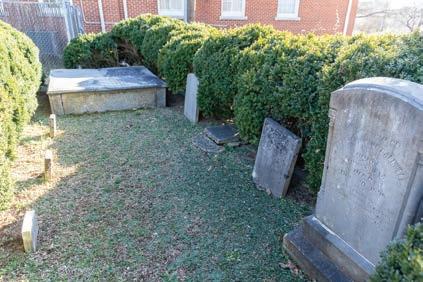
Still, a stroll among the hundreds of gravestones that remain intact, however, reads like an honor roll of Greensboro’s pioneer names — Gillespie, Forbes, Donnell, McKnight, Forbis, Dick, Lindsay, McNary, Albright, Mebane and Rankin.
Brady once set out to find the grave of her ancestor, William Rankin, but was only able to locate a faded stone belonging to
his wife, Jean. “By the time I did my research on where he might have been buried — presumably near his wife — and got back to the cemetery, even her stone had disappeared,” she says with a laugh, adding that at least 20 current church members have ancestors from the 1700s — not all soldiers — buried in Buffalo’s historic cemetery. “We feel blessed to worship where our ancestors worshiped,” she adds, “because it connects us to the rich history of Guilford County and the creation of Greensboro in a very personal way. I like to think that Buffalo Church is to Guilford County what Bruton Parish Church is to Colonial Williamsburg and the North Church to the city of Boston.”
The most celebrated grave site exists directly behind the sanctuary, a family plot framed by century-old boxwoods. It belongs to Rachel and David Caldwell, a Princeton theological graduate who was called to serve as Buffalo’s first pastor in 1765, sharing pulpit duties with Buffalo’s sister congregation just east of what is now Greensboro at Alamance Presbyterian Church for the next 55 years.
Two years after Caldwell arrived, he established what became known as Dr. Caldwell’s Log College, a theological and classical academy for young men. His students included future N.C. governors, members of Congress and at least 50 ministers. He later became a trustee of Liberty Hall, the precursor of the University of North Carolina.
Today, Caldwell’s Log College Site — home to his farm, well-preserved Federal-style house (dating from 1781) and influential school — are part of David Caldwell Historic Park, a National Historic Site that shares space with the Tanger Family Bicentennial Gardens. Come spring, there is probably no more visited public grounds in Greensboro.

In addition to Caldwell’s reputation as a spellbinding pastor,
due to a shortage of physicians in the region, he acquired medical books from Philadelphia and became a self-taught doctor, which came in handy during his years as a key patriot leader in the Revolutionary War. According to records, he was present at the Battle of Alamance during the Regulator insurrection
of May 16, 1771, and urged his flocks to volunteer during the American Revolution and the War of 1812. His farm also became a prime staging ground for American troops prior to the Battle of Guilford Courthouse, the major turning point of the war.
Rev. Caldwell died in August 1824. His wife, Rachel Craighead Caldwell, daughter of a Presbyterian firebrand patriot leader named Alexander Craighead, followed him to the grave one year later.
Just three years later, in 1827, Buffalo’s congregation replaced a previous pair of wooden sanctuaries — one of which was said to hold as many as 1,000 worshippers — with a striking brick sanctuary that is believed to be the first brick church in this part of North Carolina.
Seventh-generation member Clyde Albright’s great-great grandfather, Jacob Albright, built the sanctuary from bricks made on the property.
Just under a century later, a classical portico was added to the entrance of the sanctuary and a choir loft was constructed. Not long afterwards, an education building named for David Caldwell was built on the west side of the church. A similar structure dedicated to Rachel Caldwell was eventually added to the east side of the sanctuary, completing the evolution of the church campus.
To celebrate Buffalo Church’s bicentennial in 1956, the church underwent a major renovation and sanctuary expansion. Clyde Albright’s grandfather, Lonnie Albright Sr., showed Boren Brick where to dig the clay from the original site (reportedly near Friendly Center) used for the bricks of the expanded sanctuary.
The highlight of the celebration was a dramatic two-night outdoor pageant called Let Freedom Ring, featuring a cast and
staging crew of more than 75 members of the church, several professional actors and the choirs of Buffalo and Alamance churches. The play, presented over a trio of outdoor stages, told the story of Buffalo’s extraordinary history, from early days before the church’s founding to the achievement of America’s independence. “It was quite an exciting production,” remembers Vinnie Gordy. “There was great music, and cannons firing and lots of fireworks. I was age 12 and sang in the children’s choir. My older sister, Magie Fishburne, however, had a major role as Hannah Meeks, and my aunt, Helen Andrew, played Rachel Caldwell. There was a large turnout both nights from the community. I don’t believe anyone had ever seen anything quite like it.”
Longtime members also point out that, like many older churches, Buffalo Church has seen its ups and downs over the decades. “By 2015,” says McKnight, “we were a church with a lot of older members, many who were dying out. Before COVID hit, in fact, we were down to about 68 regularly worshipping members — probably the lowest point in the church’s history.”
Ironically, he adds, COVID proved to be the unexpected salvation. When churches everywhere were asked to shut down for the duration, Buffalo’s leadership opted to remain open, employing extreme spacing throughout its handsome sanctuary. “When the word got out that we were holding services as usual, our membership returned, along with a lot of newcomers from other churches. It may be proof that God works in mysterious ways,” McKnight adds with a smile. “But the growth has continued regularly since that time.”
Today, the congregation numbers over 200 and continues to

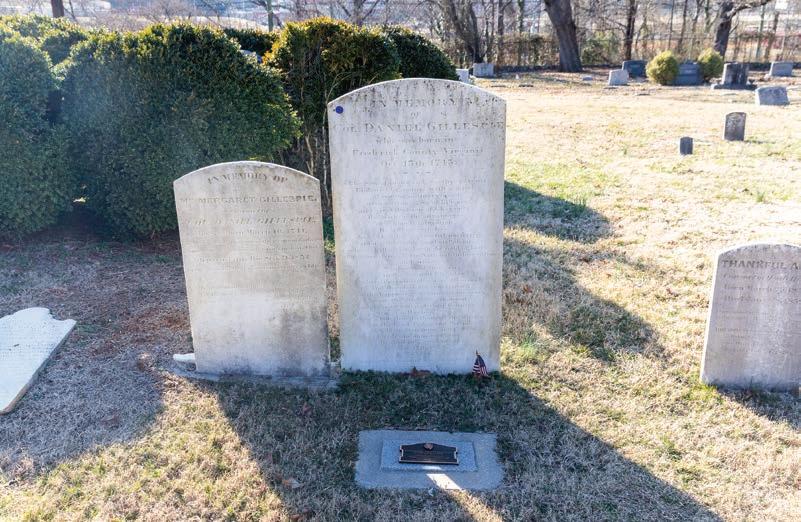
slowly grow, a timely revival for a congregation some affectionately call the “Pioneer Church of Greensboro.”
At a recent Saturday morning men’s prayer breakfast, a record turnout of more than 45 included nine newcomers who’ve recently come Buffalo’s way from other churches.
“I think they are drawn to a church where the fellowship is genuine and the preaching is firmly Bible-focused,” reflects Albright. “When I sit in the choir loft and remember where my parents and grandparents once sat, looking out over a sanctuary that is now almost full every Sunday, I think about the generations of people who were born, got married and passed their lives through this wonderful old church. I think our ancestors would be very pleased to see new faces and a church family that is growing again.”
Three decades ago, Albright — a lawyer with a gift for woodworking — took the remains of an 80-year-old white oak that met its demise through a lightning strike during a storm and made a rugged wooden cross. He wrapped it in chicken wire and planted in front of the church portico during Easter week. Last November, the same salvaged wood was used to build a larger cross, which hangs from the organ pipes in the sanctuary.
On Easter Sunday, members adorn the original cross he built with flowers before a sunrise service and congregation breakfast.
“It’s become a very popular tradition at Buffalo Church,” confirms Albright. “As the sun comes up, I think that old cross covered with spring flowers expresses our gratitude for the return of spring and the glory of Jesus Christ’s resurrection.” OH
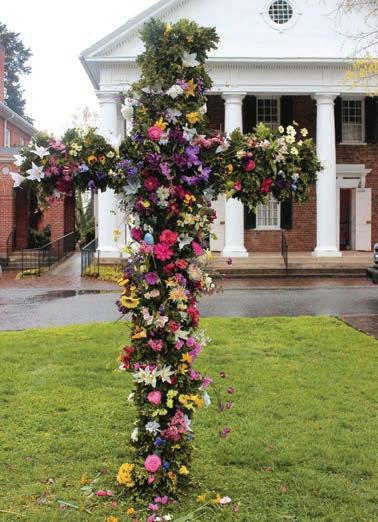
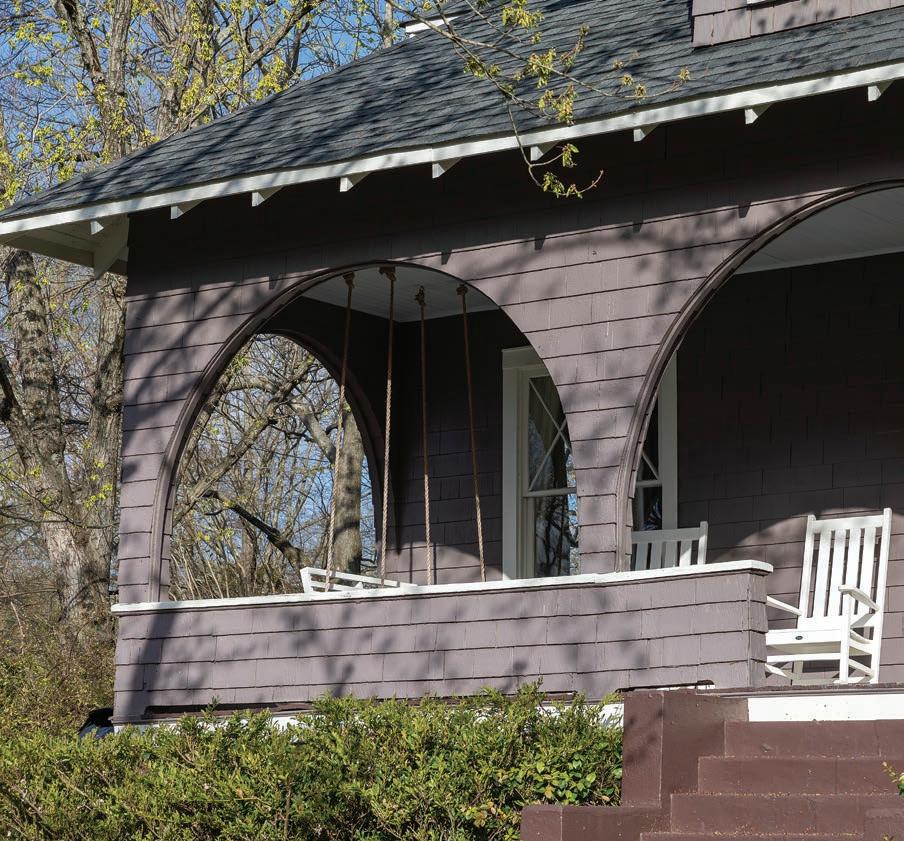
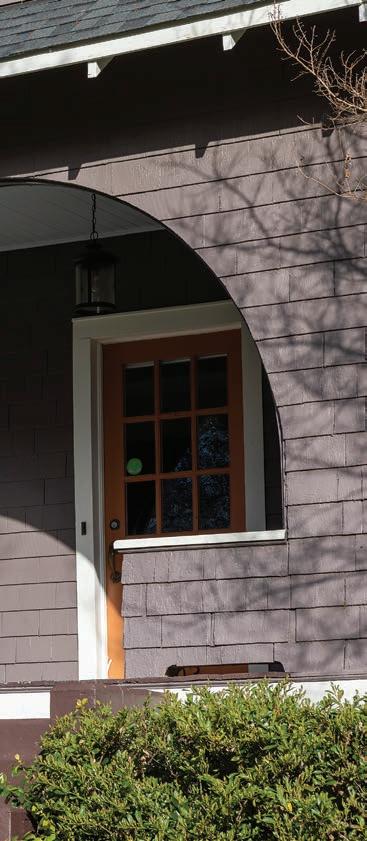
By Cynthia a Dams •
PhotograPhs By Bert anD BeCky VanDerVeen
My dad stood on the brakes whenever he spied a house featuring grand, white columns and a generous porch sweeping across the front, his dusty pickup sputtering to a stop. He stopped, fully fixated, before puttering on, often headed to an antiques auction.
“Just beautiful,” he’d sigh, shaking his head in awe.
He most admired “grand old gals,” as he called the finest homes with slate roofs, copper gutters, working shutters and Juliet balconies. He would loop through historic neighborhoods, excitedly pointing and teaching me to recognize and value those details, too. Years later, I learned he had dismantled and salvaged materials from a ramshackle house to build our first family home just before my birth, proving just how much of a house guy he was — or, at least, proving his thrifty resourcefulness.
As for me, I was captivated by the interior details of homes. What treasures were to be found inside?
And I was anything but practical.
With sparkling glass door knobs and a staircase to nowhere, even cobwebbing, cracking plaster and a dining-room floor that listed so much it gave you vertigo didn’t discourage my desire for a dodgy Westerwood home. It also possessed gorgeous molding (if an unfortunate, teensy fireplace) and a butler’s pantry — and a surprisingly serviceable floor plan featuring nooks and crannies galore. It quickly won the hearts of two neophyte homebuyers.
Old house lovers get it.
Perhaps it takes preservationists and architectural buffs to fathom the irrational, deep affection historic homes and buildings inspire. And most can quickly tell you what particular details make their pulse quicken with pleasure — and why. They have an internal catalog of favorite things — from window details to arches. According to home blogs, they are particularly smitten by

original details, especially French doors with mullions, substantial moldings and casings, ceiling details and medallions, and wall paneling.
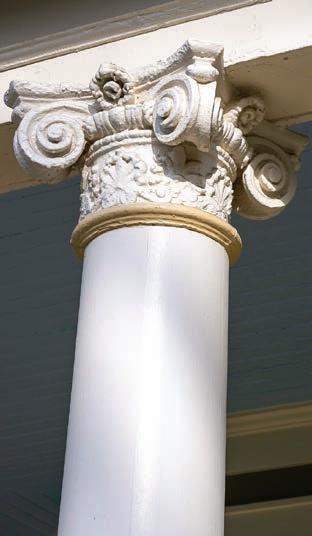
most delights.
So, I began asking some of my favorite old-house lovers, many of whom just so happen to have preservation credentials, to share some of their favorite architectural details up and down Greensboro’s streets and avenues.
Take Katherine Rowe, who lives in a classic brick two-story in the leafy and grand neighborhood of Sunset Hills and discovered a passion for historic homes while coming of age in Salisbury, where there is a thriving preservation movement.
Proof? She served as an officer of Preservation Greensboro’s Board of Directors and dedicated 21 years volunteering with its Architectural Salvage program.
Rowe currently serves as a commissioner with the Historic Preservation Commission of Greensboro (HPCG). Two years ago, she helped judge the Community Appearance Awards of Winston-Salem and Forsyth County. Vocationally, she also does “small remodels and design work.”
Architecture is a topic she delightedly calls “fun!”
If you ask what her favorite architectural detail is, Rowe hesitates to narrow it to one. Soon, she’s tripping over things she finds riveting. Firstly, she mentions the purple glass exterior sconces and cast concrete door surround at the old Masonic Temple on West Market Street “because they are so much themselves; bold, colorful. Meant to look a bit imposing, but they’re just adorable.”
Rowe has difficulty choosing a single architectural detail that

Then she discusses the elaborate castconcrete Art Deco molding around windows “at 100 S. Eugene, next to the sheriff’s office, which are delightful because they are such a surprise. Detailed. A lot of work, and I appreciate the thought behind those windows, both from the architect and the guy who made them.”
Later she emails a list of admired architectural details around town, noting:
The miles of slate roof at Holy Trinity; graceful, symmetrical classical architecture at Temple Emanuel; arches and garages doors at the now defunct Central Fire Station on North Greene; robust arches at a private residence at 703 Fifth Ave. in Dunleath; the restored Gatekeeper’s Cottage (originally part of Green Hill Cemetery, now Carolina Home Partners) on Wharton Street; public spaces that are inspirational, such as War Memorial Stadium and East White Oak Community Center.
“There’s lots of good public architecture, right?” Rowe notes. “Charles Hartmann was responsible for much of it,” she adds, ticking off his greatest hits: “Grimsley High, Dudley High, the original Jefferson-Pilot building with Thomas Jefferson bust and Country Club Condos on Elm Street.”
On a personal note, she sends an email later, saying she was initially drawn to her home’s long sunroom with its three walls of
windows and red quarry tile floor. “It reminded me of my greatgrandmother’s sunroom in Albemarle; hers had jalousie windows, tropical barkcloth upholstery and bright, floral houseplants. Charming and cheerful to a child.”
Now that their sunroom is insulated, she and her husband, Jeri, spend weekend afternoons there reading or watching television. “And I bring in pots of geraniums and clover to overwinter on tables set up in front of two of the window walls. Which seems a bit full circle, don’t you think?”
Fellow volunteer, writer and preservationist David Arneke has also served with HPCG. Like Rowe, he has been an officer of Preservation Greensboro. He currently serves on the nonprofit Preservation Greensboro Development Fund.
Since 2017, he has written and edited piedmonthistorichomes.com, which serves as a comprehensive guide to “the most historic, notable and distinctive 18th-, 19th- and early- to mid-20th-century homes now for sale in North Carolina’s Piedmont Triad region.”
Notably, Arneke knows about succumbing to old house charms. For many years, he has lived in a circa 1900 College Hill home with Betty Work. Lured by certain charming architectural details when he first saw their future house, one distinction eclipsed all others.
house is remarkable, but that roofline, along with the portico, give it a whimsical look that you just don’t see very often. I get the feeling someone had fun designing that house.”
Fellow preservationist Deborah Kaufman, who lives in Sedgefield and now serves as an at-large commissioner on HPCG, says, “I absolutely love the front porches of older homes. They always make me nostalgic, especially if there’s a porch swing. I’m reminded of my childhood at my great-grandparents’ house.”
She qualifies details.
“Brick porch flooring and wrought iron rails just don’t give me the same warm feeling as those creaky wooden floors and white railings.”

“The feature that really grabbed us was the scalloped frieze boards that go all the way around the house. They were hard to even see when we bought the house because the entire exterior was painted beige — every last detail.” According to a November 1997 Greensboro News & Record interview, the couple took three years deliberating the perfect exterior paint colors.
“Also, inside the house, the back stairs,” he adds. “Neither of us had ever lived in a house with stairs in the front and in the back. Such a novelty for us.”
Having long chronicled features of older homes, he admires the columns on the Bumpas-Troy House, saying their size and prominence “make them grand and spectacular and unlike anything else in the neighborhood.” He muses, “It must have been quite a sight when it was built in 1847, out in the woods beyond the edge of town with no other houses around it.”
Arneke discusses a Dunleath home, which turns out to be the same one that Rowe had mentioned, notable for its “wonderfully distinctive front porch. I don’t remember seeing another one like it in Greensboro.”
Arneke recalls a striking historic feature of a Fisher Park house.
“The swooping roofline on 1101 Virginia Ave. . . . The whole
Even Greensboro City planner and preservationist Mike Cowhig, a Fisher Park resident, agrees with Arneke and Kaufman on the topic of porches, particularly when it comes to what’s directly under foot. In a word, Cowhig finds the commonplace touchingly affecting — and often overlooked.
“There’s nothing like a well-preserved set of wood front porch steps and a tongueand-groove porch floor,” he says.
“Because they are exposed to the weather, [wooden] steps are often replaced with masonry steps, so they are increasingly rare. The treads are usually bullnose with a rounded edge like stair treads. Victorian era steps can have very decorative hand railings.”
As for historic tongue-and-groove porch floors? A yawping hole opened like a sinkhole in that Westerwood’s tongue-and-groove porch — just as I stepped out for the mail during our first week of residence.
Said porch’s beguiling Chippendale-style railings were rotting and much of the German siding cladding the entire house was also rotten. Only the concrete steps were not.
The next house that captivated us sold itself within minutes, even lacking a requisite front porch. But inside, it had handmade doors, brass knobs and gorgeous, deep windows (with wavy glass in the muntins!) offering a park view. Built in 1926 by former Greensboro mayor Ralph Lewis, we considered it “modern.” Sadly, the gorgeous slate roof was developing leaks, eventually requiring replacement a few years ago. As did the heating, air conditioning and rotting Tuscan columns at the front entry and side porch.
But those windows with wavy glass? They survived, and they still slay me.
I was willing to overlook almost anything for its many sets of French doors (three!) and remarkably — how to express this to a saner person? — calming energy. Laugh if you want, but the plaster walls inside our old house feel like a safe, sheltering place.
Especially so if you forget the resident ghost. OH

A big-city transplant brings verve to a 100-year-old bungalow
By M aria Johnson
PhotograPhs By a M y FreeM an


About a dozen years ago, Richard Peterson was walking down Greensboro’s North Eugene Street where it feathers from the commercial glassiness of downtown into the residential coziness of Fisher Park, when he saw a 90-some-year-old lady.
She was faded and outdated.
But she had class.
And good bones.
Peterson, once a jet-setting New York hair stylist with A-list clients, saw what she could be. So he did what he usually does: He made the most of her attributes, which, in this case, included a deep front porch, cedar shakes and rosy-brick walls stacked in a Flemish bond pattern, with alternating long and short sides in every course.
In the decade-plus since he bought the compact cottage, Peterson has artfully used tones from that brick palette — ranging from salmon to russet — to splash the property, inside and out, with blushing accents balanced by calming greens.
Now, especially in the spring, when the home’s English-flavored garden froths with blossoms inside the peaked waves of a boxwood hedge, the old Craftsman dame, petite though she may be
at 1,000 square feet, still turns heads.
Her show stopper: the crown of pink Eden roses climbing above her front porch.
“When the roses are in bloom, people stop and take pictures,” Peterson says proudly. “If I’m outside, they tell me how beautiful the garden is and how much they enjoy seeing it.”
An anonymous passer-by once dropped off a pack of note cards with a picture of the house on the front.
“I think it’s a testament to the fact that the community around here is very thoughtful,” he says. “It’s a great place to live.”
Fifteen years a Piedmonter, Peterson still looks the part of Manhattanite with his oval glasses, shock of Warhol-white hair, low-cut Chuck Taylor sneakers, and jeans, henleys and hoodies in every conceivable shade of black.
Recently, he walked into a Greensboro furniture store.
“You must be from New York,” a saleswoman said.
How Peterson landed in Greensboro is as interesting as the transformation of his cottage from weary to whimsical.
He recounts some of his earliest memories as a child growing up outside Cleveland, Ohio, in the 1950s and ’60s. His father took the family for Sunday drives through swanky Shaker
Heights, where the captains of shipping, steel and banking lived in grand homes.
Peterson wondered what life was like behind those walls. His life was modest by comparison. His father owned a gas station. His mother was a housewife. His maternal grandfather, a Hungarian immigrant, tended a flower-and-vegetable garden behind the house that the two families shared.
Peterson was about 8 when his family moved to their own home, but he never forgot the flowers, partly because his grandfather incubated cuttings under Mason jars and literally passed on the beauty to the next generation.
When Peterson was 16, he went to work for a florist in Shaker Heights.
He accompanied the shop’s owner to the homes of wealthy clients to gather pretty vases, take them to the shop, fill them with botanicals and deliver them back to their stately homes. Peterson
had found a way into the mansions that wowed him as a kid, and he liked what he saw.
“I drove my family crazy because all of a sudden I wanted Waterford and Baccarat crystal and sterling silver,” he says.
Soon, Peterson was arranging flowers.
Acting on the encouragement of a life partner who was a hairdresser, Peterson diverted his flair for composition into beauty school, where he learned how to snip, color and texture hair. He and his partner opened several salons in Cleveland.
“We were extremely successful,” Peterson says.
The couple moved to New York City in the late ’80s after Peterson snared a job with the late Kenneth Battelle, aka Mr. Kenneth, the darling of New York society women who wanted the cachet of being shorn by the man who is often described as the first celebrity hairdresser.
Mr. Kenneth created Jackie Kennedy’s iconic bouffant. Marilyn



Monroe, Brooke Astor, Audrey Hepburn, Babe Paley, Katherine Graham, Nancy Kissinger, Joan Rivers and other notable noggins sat in his chair — but only for a cut.
Mr. Kenneth passed his wet-headed clients to his employees for styling. Peterson dried, combed, teased and lacquered his way into a loyal following.
He styled and schmoozed with Pamela Harriman, who was once married to Rudolph Churchill, the son of Sir Winston. Two husbands later, she was hitched to Averell Harriman, the U.S. Secretary of Commerce under President Harry Truman. Peterson groomed the heads of many women affixed to heads of state.
When First Lady Betty Ford was in town, Peterson did her ’do. She told him about an Italian restaurant that she and the President liked. Peterson said that he’d love to take a friend there.
Ford made a reservation for them. When dessert was finished, Peterson called for the check. He was told that the dinner was compliments of Betty and Jerry Ford.
When the Crown Princess of Sweden was in New York and needed her hair styled, Peterson reported to her suite at the Waldorf Astoria; Mr. Kenneth’s salon was inside the hotel.
At the suite, Peterson was greeted by a man who led him to a room where he could work. Peterson directed the man to move some furniture so that the princess could sit in the best light.
After the princess was coiffed, her father walked into the room, and it dawned on Peterson who had helped him.
“I had the King of Sweden moving furniture around for me,” he says, dissolving into laughter.
With Mr. Kenneth’s blessing, Peterson worked part-time as a personal hairdresser to the CEO of two apparel companies. He traveled the world on her private jet.
“I was feeling all big-shot-like,” says Peterson. “It was a shock the first time I had to fly coach.” Except for a year-long stint with a salon in Palm Beach, Fla., Peterson camped in New York. He and his partner lived in an Upper West Side apartment overlooking Central Park, in the same building where actors Al Pacino and Andie MacDowell lived.
But, after a while, Peterson says, the magnets of love and work in the big city lost their pull. He started looking for a place to move solo. Someplace green, where he could have a yard. Someplace like his boyhood home, only warmer.





It just so happened that a friend, another New York stylist, flew to Greensboro every six weeks to style the hair of a local socialite he’d met in the Big Apple. Soon, he was doing the hair of several of her Greensboro friends. Peterson tagged along to help on one of those trips. During the visit, Peterson and his friend attended a drag bingo event in downtown Greensboro.
“The majority of the audience was straight people, and everyone was having a good time,” Peterson says. “It told me that this place was open and accepting. I thought, I could easily live here.”
A few phone calls later, he had a job at an upscale salon on North Eugene Street. He rented a room on Summit Avenue, watched way too much HGTV and set his sights on restoring an older home.
“I can’t tell you how many power tools I bought,” he says.
He haunted salvage stores, demo sites and antique shops, squirreling away hardscape for his someday yard: a wrought iron arch, a double metal gate, a white picket fence.
One day, as he walked down North Eugene, an aging swan caught his eye.
The sign out front said, “For Sale or Rent.”
Peterson rented with an option to buy. Then he opened his wallet.
He had the hardwood floors refinished and stained dark before he moved in.
Later, with deed in hand, he shelled out for a new roof, water heater, HVAC system and basement waterproofing.
The financial hits kept coming.
Inside the cottage, wood paneling peeled away from the walls. Under that, the original plaster flaked away. And under that, a brick wall crumbled. It was one of two side-by-side brick walls separated by a gap, an energy-saving style known as cavity construction, common in 1924, the year house was built.
Peterson had the inner brick wall repointed, hung with drywall and painted bright white.
Most of his backgrounds are black, gray or white.
“Everything looks better around white,” he says.
He hewed to the blanc baseline when he updated the kitchen to include Shaker-style cabinets, stainless appliances and white, vinyl floor tiles veined to resemble Carrara marble.
He added floor-to-ceiling windows in the sunroom, where he often watches TV with his Labrador retriever, Sammy, Waves of sunset and emerald tones — in the form of houseplants, artwork and punchy artifacts — carry the eye throughout the house. See a mannequin sheathed in pink sequins in the


front room; a large metal pig in front of a Louis XVI repro desk in the middle room; and flying pigs perched in the sunroom.
The glee continues in the backyard with curvaceous rosecolored balusters around porches — including a small wedge that Peterson calls his “Juliet Balcony” — fan-back garden chairs and faux flamingos.
The blushing accents pop against vivid green islands of artificial turf, which Peterson installed so his dog could go outside without stamping the house with muddy paw prints.
The rest of the backyard resembles a wooded hallway. With help, Peterson sculpted fieldstone paths and planting beds down the length. He decked the hall with river birches, azaleas, ligustrum, distylium and ferns.
The walkway ends with a project in progress, an empty landscape-block pond that Peterson envisions catching a tumbling waterfall.
“My wish is to be in a forest,” he says.
For the front yard, his wish is to be in the Cotswolds.
The metal gate, which he found at the now-shuttered Mary’s Antiques soon after moving here, is flanked by concrete orbs given to him by a client. She imported the balls from England.
“I can’t imagine what it cost to ship them,” Peterson says.
He added salvaged porch railings, balusters and a swing.
“No Southern porch is complete without a swing,” he says.
He filled the slatted seat with faux pillows and a throw that he made with spray foam, chicken wire, concrete slurry and paint. He spiked the arrangement with a gazing ball and contained the arrangement with a chain. The spectacle was made for eyes, not fannies.
Ditto the garden tucked between hedge and porch. In season, the space bubbles with a fountain that provides mood music for ferns, roses, azaleas, Asiatic jasmine, coleus, zinnias, impatiens, verbena and whatever else strikes Peterson’s fancy.
He bought a small pickup truck after moving to Greensboro, and he finds it difficult to pass a nursery without loading the bed with more plants.
“I was better off when I had a car, and not a truck, because now I’m not restricted,” he says.
He makes no apologies for his devotion to natural beauty, though.
“If you look at a flower — the color, the shape, the fragrance, everything — it’s a miracle,” he says.
He lets his observation hang before seeking a response.
“Isn’t it?” he finally asks.
The voice belongs not to a jaded urbanite, but to an awestruck kid. OH

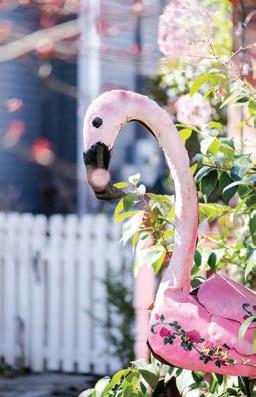
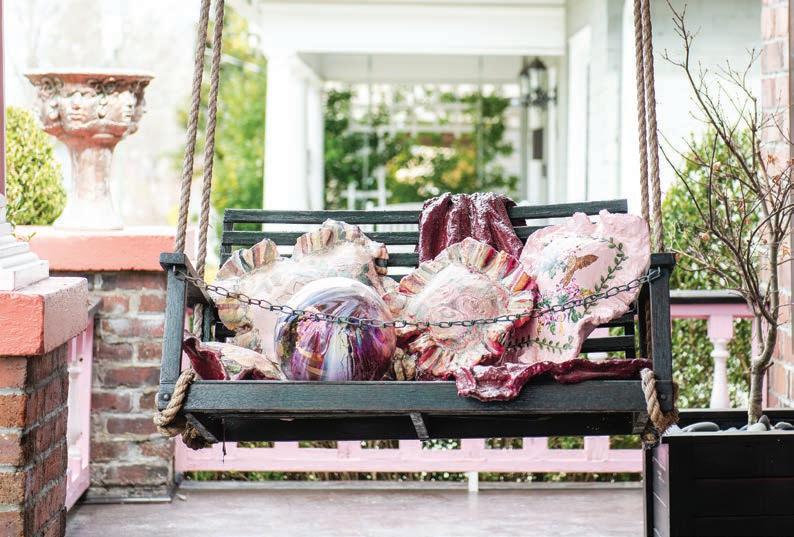

Downtown Greensboro invites you to embark on a culinary journey where you can sample diverse cuisines, immerse yourself in unique atmospheres, and experience an array of savory styles, all within a convenient stroll.
See for yourself, in Downtown Greensboro.

By a shley Walshe

April is a drift of dandelions, cheerful and bright. Can you hear them giggling? Listen. It helps if you slip off your shoes.
Somehow, bare feet in the cool grass, you can access new frequencies: the whir of tiny wings, the swelling of tender buds, the rhythmic flow of nectar.
Wiggle your toes. Breathe into your belly. Surrender to the urge to lie down.
Yes, that’s better. Draped across the softening earth, the sun on your skin is medicinal. You close your eyes, brush fingertips across feathery blossoms, let your inner child run wild.
Perceive the world through the eyes of a dandelion. Anticipate the tickle of bee feet, the tender kiss of mourning cloak, the ecstasy of thunder and rain.
Are you giggling yet?
Listen.
The song of spring rises in all directions.
In the distance, a chorus of peepers rouses the burgeoning woods. Wet and trembling, a swallowtail clings to its chrysalis, pumping crumpled wings at the speed of grace. A bluebird whistles tu-a-wee.
Open your eyes. Turn your gaze toward the flowering dogwood, the mighty tulip, the small, ambrosial apple tree. Everywhere you look, spring spills forth.
The dandelions are chattering now. Turn a cartwheel, one squeals. Dance for rain, blurts another. Pick me, whispers a third.
Smiling, you reach for a fat, yellow blossom, pluck the stem, tuck the flower behind your ear. Eyes closed once more, you drift into blissful reverie. Among this sea of sprightly yellow orbs, you drink in the playful hum of this budding season, let the song revive your every cell.
April, the angel of the months, the young love of the year.
—Vita Sackville-West
The Victorians used tussiemussies (nosegays) to express their true feelings. Apple blossoms and dogwood were code for I like you. Purple violets murmured true love. Tulips? Well, that would depend on the color, of course.
While the language of flowers has withered in these less-than-modest times, we can’t help but ascribe meaning. Surely, every gifted flower says, I’m thinking of you. But what is it that you hear in the presence of flame azalea, redbud, cherry blossom? What do you glean from the iris and bluebell?

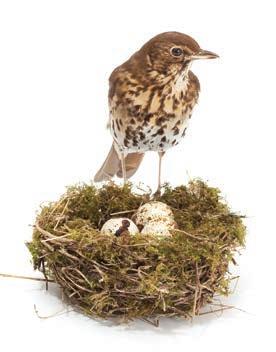
There, nestled in the branches of dogwood, sugar maple, hawthorn and pine; in gutters, rain boots and dense shrubs; within the cavities of dead and living trees: eggs, eggs, beautiful eggs. Creamy white ones, speckled brown (chickadee, cardinal and nuthatch). Bright and muted blue ones (robin and bluebird). Pale green with rust-colored blotches (mockingbird). And guess who’s out searching for them? Opossums, snakes, skunks, racoons, crows and jays. Spring is as harsh as it is lovely. And, yet, this circle of life is indeed what makes each spark of creation all the more precious. OH
Boxwood Antique Market
Carolina Pines Retirement Community
Chelsea on Green
Compassionate Wildlife Removal
Craig McIntosh/Tyler Redhead & McAlister
Crawlspace Medic
ETC for the Home
Five Star Painting

Golden Oldies Antiques
Guilford Garden Center
Jaree Todd/Berkshire Hathaway HomeServices
June Delugas Interior Design
KMD Homes Team/COMPASS Kim Kesterson Trone
Kitchen Express
Kitchen Tune-Up
Laura Redd Interiors
MM Interior Design Group Murphy’s Upholstery










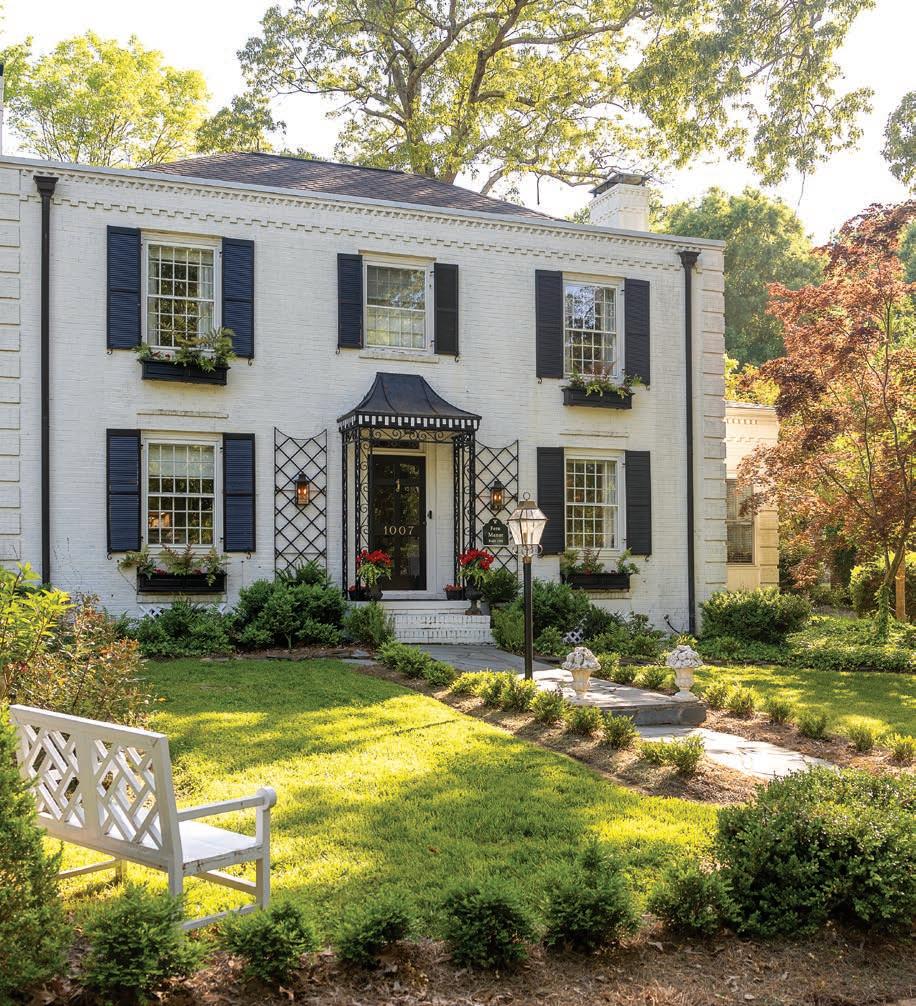
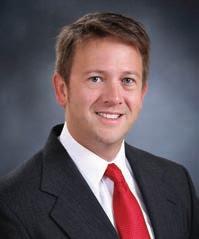

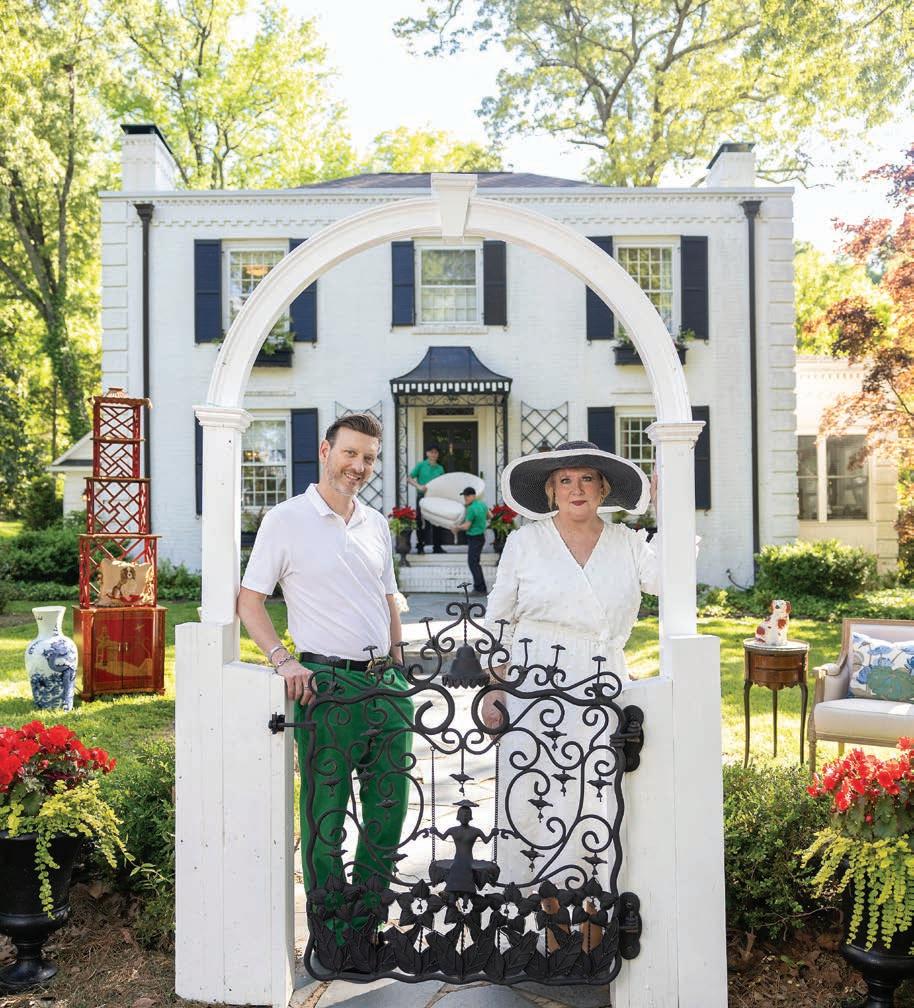











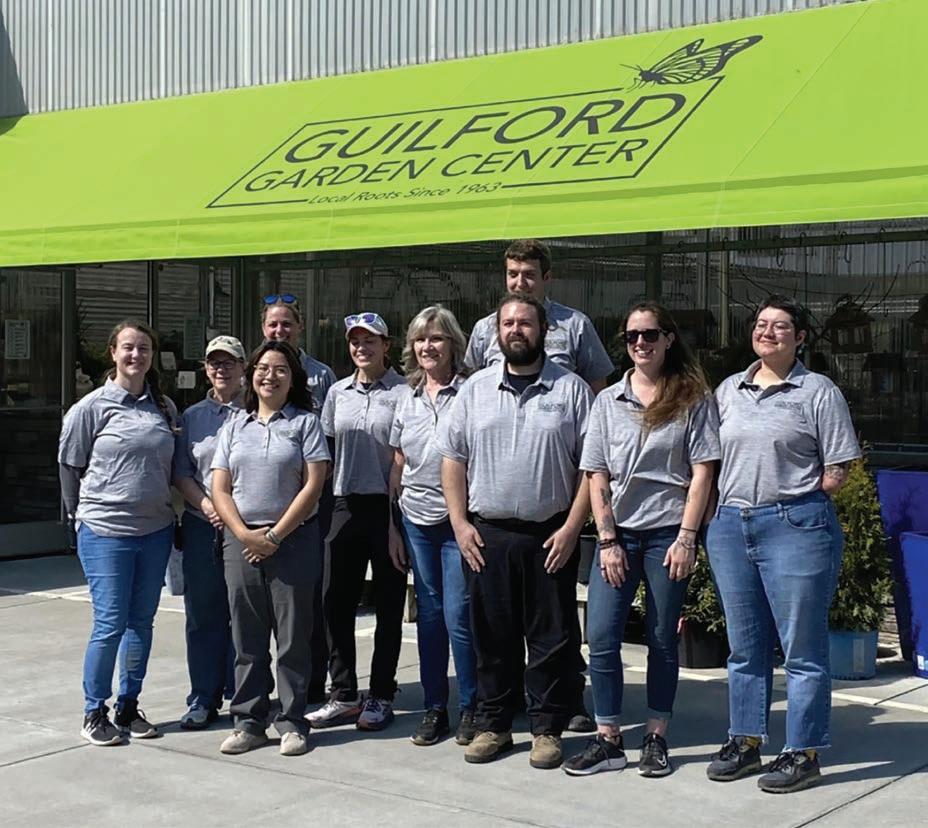





Monday - Friday: 10:00a - 5:00p | Saturday: By Appointment Only | Sunday: Closed


Priba Furniture and Interiors, a family-owned staple since 1972, blends luxury, craftsmanship, and personalized service. With a stunning 55,000 sq. ft. showroom featuring 350+ brands, Priba offers complimentary interior design services and exclusive discounts on floor samples. Led by Scott and Kim Knox, their hands-on approach ensures every client finds the perfect piece. Whether custom ordering or selecting from curated collections, experience the Priba difference—where style, quality, and service come together seamlessly.

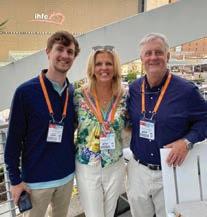


Before owning Murphy’s, we owned a gift store on Battleground called Party Chick and Paper.
With recent changes in the retail landscape in Greensboro, we have brought back the “Best of the Chick”.
We have divided the showroom at Murphy’s Upholstery into 2 parts - one half top quality furniture, home decor and fabric and the other half filled with the gifts you love!
It’s the most unusual location with the most fabulous gifts in town!





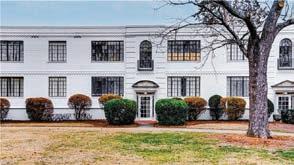






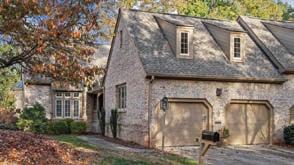
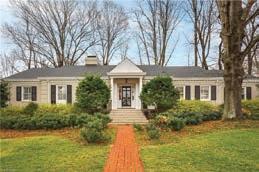

T h e m a r k e t i s n ’ t s l o w i n g a n d n e i t h e r a m I !
C l o s e w i t h C r a i g
B r o k e r / R e a l t o r ® 3 3 6 . 2 1 0 . 5 3 3 7 m o b i l e
c r a i g . m c i n t o s h @ t r m h o m e s . c o m t r m h o m e s c o m



Save the date!
May 17th & 18th 12pm-4pm
Preservation Greensboro's 15th Annual Tour of Historic Homes & Gardens will be held in Irving Park, a picturesque downtown suburb, planned and developed in the early 20th century to be Greensboro's ultimate park community.
The Tour of Historic Homes & Gardens is Preservation Greensboro’s largest fundraising event. Come out and support this incredible organization and get your fill of local history!
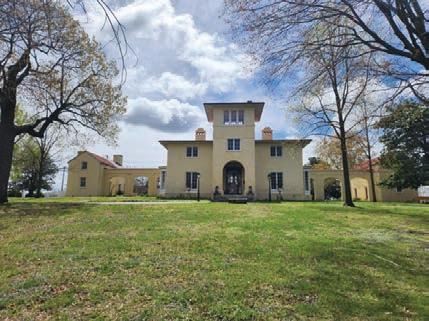




















































Create the ultimate outdoor retreat with:
Insolroll® patio shades
Block glare, heat, and UV rays while enjoying your view.
Custom cushions
Refresh your outdoor furniture with fade-resistant, durable Sunbrella® fabrics in stunning colors and patterns. Transform











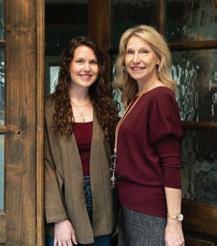







As spring breathes new life into our 43-acre community, it’s the perfect season to embrace fresh beginnings at WhiteStone. Come tour our inviting residences and experience the warmth of a community that feels like home.
After years of planning for your ideal retirement, step into the refreshing serenity of WhiteStone—where every day is full of new possibilities. Call us today at 336-652-3415 to schedule your personal appointment.
700 S. Holden Road | Greensboro, NC 27407 liveatwhitestone.org







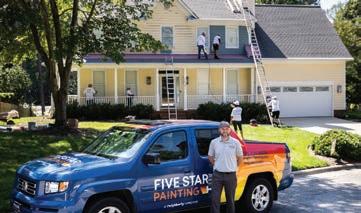

















Before attending any event, it’s best to check times, costs, status and location. Although we conscientiously use the most accurate and up-to-date information, the world is subject to change and errors occur!
April 1–30
OF WINGS AND FEET. See the giant, papîer-maché puppets created by Paperhand Puppet Intervention and learn about their impact at an exhibit sure to fuel your imagination; public opening to be held from 5:30-–7:30 p.m., Saturday, March 22. Free. GreenHill Center for NC Art, 200 N. Davie St., Greensboro. Info: greenhillnc.org/events.
MAKING CONNECTIONS. This installation of works from the Weatherspoon’s attic showcases the gallery as an academic museum with deep connections to its campus, Greensboro and broader communities. Free. Weatherspoon Art Museum, 500 Tate St., Greensboro. Info: weatherspoonart.org/exhibitions/ current-exhibitions.
ANDREW WYETH. “Andrew Wyeth at Kuerner Farm: The Eye of the Earth” explores the connection between one of the most celebrated 20th-century American artists and a particular farm in his hometown, Chadds Ford, Penn. Reynolda House Museum of American Art, 2250 Reynolda Road, Winston-Salem. Admission info: reynolda.org/museum/ exhibitions.
April 1–26
CRIP*. This group exhibition features contemporary artists exploring disabilities and the ways their personal experience of disability intersects with other aspects of their lives. Free. Weatherspoon Art Museum, 500 Tate St., Greensboro. Info: weatherspoonart.org/exhibitions/ current-exhibitions.
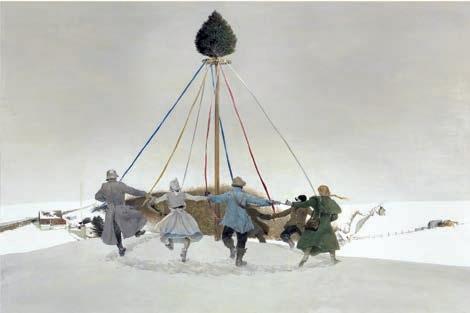
April 1-30
• Reynolda House Museum of American Art
April 2
READING THE WORLD. 7–8 p.m. Discover contemporary authors’ works in translation, such as this month’s selection — a novel of man’s relationship with nature, faith and the vitality of storytelling — The Understory by Thai author Saneh Sangsuk. Free. Online. Info: scuppernongbooks.com/event.
April 3
GOTHICTOWN. 6 p.m. Bestselling thriller author Emily Carpenter discusses her newest work. Free. Scuppernong Books, 304 S. Elm St., Greensboro. Info: scuppernongbooks.com/events/calendar.
April 3–6
SHORT PLAYS. Times vary. Creative Greensboro presents the Greensboro Playwrights Forum’s annual Evening of Short Plays, featuring those written by its members. Tickets: suggested $10 donation at door. Stephen D. Hyers Theatre at the Greensboro Cultural Center, 200 N. Davie St., Greensboro. Info: greensboronc.gov/government/city-news/city-calendar.
April 4–13
HAIRSPRAY. Times vary. Groove along to the upbeat tunes of this family-friendly
musical, piled bouffant-high with laughter and romance. Tickets: $15+. Starr Theatre, 520 S. Elm St., Greensboro. Info: ctgso. org.
April 4–5
FIREFEST. 1–10 p.m Friday, 10 a.m.–10 p.m. Saturday. Celebrate incredible art with tours, workshops, demonstrations, special guest artists, live music, food trucks and exciting activities, including Friday’s Kids Draw It, We Make It demonstration. Tickets: $10/day. Starworks, 100 Russell Drive, Star. Info: starworksnc.org/ starworks-events.
April 4
TRIPLE CROWN CASINO NIGHT. 5:30 p.m. Sip cocktails, nosh on appetizers as well as a gourmet dinner, bid in a live auction, and play your favorite casino games, all to benefit Pretty in Pink Foundation, which supports uninsured and underinsured breast cancer patients. Tickets: $150. Legacy Stables & Events, 4151 Thomasville Road, Winston-Salem. Info: onecau.se/tccn25.
FRISSION ENSEMBLE. 7:30 p.m. Enjoy an evening of tunes from one of the most popular chamber music groups in America. Free, or “pay-what-you-can.” Van
Dyke Performance Space, 200 N. Davie St., Greensboro. Info: musicforagreatspace. org/season.
R&B INVITATION TOUR. 8 p.m. Eric Benét, Joe and Musiq Soulchild come together for a night of smooth vocals and timeless tunes. Tickets: $82.15+. Steven Tanger Center, 300 N. Elm St., Greensboro. Info: tangercenter.com/events.
THE TROUBLE UP NORTH. 6 p.m. Durham-based author Travis Mulhauser chats about his latest work, a haunting novel about a family of bootleggers. Free. Scuppernong Books, 304 S. Elm St., Greensboro. Info: scuppernongbooks. com/events/calendar.
FIRST FRIDAY. 6–9 p.m. Head downtown for a night of live music and happenings stretching all the way from LeBauer Park and the Greensboro Cultural Center to the South End. Free. Downtown Greensboro. Info: downtowngreensboro. org/first-friday.
JUSTIN FURSTENFELD. 8 p.m. Spend an MTV Unplugged-style evening with the frontman of Blue October. Tickets: $48.25+; ages 16+. Piedmont Hall, 2409 W. Gate City Blvd., Greensboro. Info: gsocomplex.com/events.
April 5, 12, 26
BLACKSMITH DEMONSTRATION. 10 a.m.–4:30 p.m. Watch the sparks fly and red-hot iron turn into farm implements as the past is recreated under the able hands of a costumed blacksmith. Free. Historical Park at High Point Museum, 1859 E. Lexington Ave., High Point. Info: highpointmuseum.org.
April 5
PRECIOUS RUBBISH. 6 p.m. Kayla E. discusses her debut graphic novel about trauma recollection, told in the style of postwar children’s comics. Free. Scuppernong Books, 304 S. Elm St., Greensboro. Info: scuppernongbooks.com/events/calendar.
CARDBOARD ROBOT PARADE. Noon–3 p.m. Build your own wearable cardboard robot and march in the parade of creativity. Free. UNCG campus. Info: cardboardrobotparade.com
April 6
KAKALAK READING. 2 p.m. Writers featured in the Kakalak 2024 anthology take turns at the mic reading from the collection. Free. Scuppernong Books, 304 S. Elm St., Greensboro. Info: scuppernongbooks.com/events/calendar.
KILLSWITCH ENGAGE. 6:30 p.m. Get ready to rock with this metalcore band out of Massachusetts. Tickets: $59.55+. First Horizon Coliseum, 1921 W. Gate City Blvd., Greensboro. Info: gsocomplex.com/ events.
April 7
KIRSTEN MILLER. 7 p.m. Kick off National Library Week by spending the evening with a conversation between The New York Times-bestselling author of The Change and Laura Beth Vietor, aka LB Lover of Books. Free. Central Library, 219 N. Church St., Greensboro. Info: library. greensboro-nc.gov.
NAME THAT BIRD. 5:30–7 p.m. The Piedmont Bird Club guides a leisurely stroll while teaching beginner bird identification. Free, registration required. Morehead Park Trailhead, 475 Spring Garden St., Greensboro. Info: downtowngreenway.org/events.
April 8 & 15
YOUNG ARTISTS KOLLECTIVE. 4–5:15 p.m. The YAK Club provides budding artists the opportunity to experiment with materials and processes. Registration: Nonmembers, $45; Members, $40.50. April 8, Grades K–2; April 15, Grades 3–5. ArtQuest at GreenHill Center for NC Art, 200 N. Davie St., Greensboro. Info: greenhillnc.org/events.
April 8
ASHLEY JUDD. 7:30 p.m. The actress and advocate takes the stage as part of the Guilford College Bryan Series to discuss mental health and wellness. Tickets: $69.80+. Steven Tanger Center, 300 N. Elm St., Greensboro. Info: tangercenter. com/events.
PLATES WITH PURPOSE. 6:30–8:30 p.m. Join the Junior League of Greensboro for an unforgettable tasting experience
featuring local chefs and libations that will also help fight hunger in our community. Tickets: $45. Wiseman Aquarium at the Greensboro Science Center, 4301 Lawndale Drive, Greensboro. Info: greensboro.jl.org/our-events/plates-with-purpose.
THE TERMINATOR. 7 p.m. Catch the Carolina Classic Film on the big screen — because we don’t know if it will, in fact, be back. Tickets: $8. Carolina Theatre, 310 S. Greene St., Greensboro. Info: carolinatheatre.com/events.
BURNEY SISTERS. 8 p.m. This sibling duo is redefining indie-folk with their soulful harmonies and heartfelt lyrics. Tickets: $28. Flat Iron, 221 Summit Ave., Greensboro. Info: flatirongso.com/events.
JEWELRY TRUNK SHOW. 3:30–7:30 p.m. Peruse the dazzling creations of Raleigh-based artisan Sarah Tector. Free. GreenHill Center for NC Art, 200 N. Davie St., Greensboro. Info: greenhillnc. org/events.
TAN AND SOBER GENTLEMEN. 8 p.m. Born and raised in North Carolina, this group, known for their Irish-Appalachian blend, is joined by Driftwood. Tickets: $22.60+. Flat Iron, 221 Summit Ave., Greensboro. Info: flatirongso.com/events.
NURSE JOHN. 7 p.m. This nurse turned comedian knows that laughter is the best medicine. Tickets: $50.30+. Steven Tanger Center, 300 N. Elm St., Greensboro. Info: tangercenter.com/events.
A JEWISH APPENDIX. 6 p.m. Known for lively baseball writing and his acclaimed biography of the rock music legend Chrissie Hynde, writer Adam Sobsey discusses his deeply personal memoir of reckoning with his Jewish identity. Free. Scuppernong Books, 304 S. Elm St., Greensboro. Info: scuppernongbooks.com/events/calendar.
UNCG JAZZ ENSEMBLE II. 7:30 p.m. The ensemble performs its last concert of the year, a big-band celebration of great music from the “Screen Scene.” Tickets: $7+. The Crown at the Carolina Theatre, april calendar

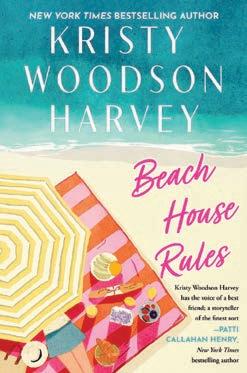
Tuesday, May 27, 2025 • 11:30 a.m. - 1:30 p.m.
Save the date! Put on your flip-flops and kick off summer by diving into the perfect beach read.
O.Henry magazine proudly hosts the launch of the latest novel from North Carolina’s own New York Times-bestselling author of 11 books, Kristy Woodson Harvey. Enjoy two of our favorite things — lunch and literature — as Kristy discusses Beach House Rules. In this book, Charlotte Stillery and her daughter have been locked out of their home by the FBI after her husband is arrested for committing a white-collar crime. The mother-daughter duo find solace in a small coastal Carolina town community — until skeletons in the closet threaten their newfound friendships.
Enjoy a delicious sit-down meal crafted by the Grandover Resort chef and a thrilling talk, followed by a Q&A session and book signing.
Tickets include a copy of Beach House Rules as well as your meal.
Supported by:


Book your tickets today at:

310 S. Greene St., Greensboro. Info: carolinatheatre.com/events.
HOT GLASS, COLD BEER. 5:30 p.m.
Enjoy glass blowing demonstrations while grooving to live music, sipping craft beers and noshing on food truck fare. Tickets: $5. Starworks Exhibition Gallery, 100 Russell Drive, Star. Info: starworksnc.org/ starworks-events.
April 11–13
SIDE SHOW. Times vary. Step right up and behold a mesmerizing musical that explores the lives of the legendary conjoined twins, Daisy and Violet Hilton. Tickets: $5.49+. UNCG Auditorium, 408 Tate St., Greensboro. Info: vpa.uncg.edu/events.
April 11 & 13
GLORY DENIED. 7:30 p.m. & 2 p.m.
This contemporary opera, set during the Vietnam War, tells the heartbreaking story of Colonel Jim Thompson, America’s longest-held prisoner of war. Tickets: $58.71. Greensboro Day School’s Sloan Theatre,
4401 Lawndale Drive, Greensboro. Info: greensboroopera.org.
April 11
BRUBECK’S DOUBLE GUITAR
CONCERTO. 7:30 p.m. Greensboro Symphony Music Director Christopher Dragon leads an exhilarating night of music featuring guitarists Thomas Flippin and D.J. Sparr. Tickets: $42.35+. Steven Tanger Center, 300 N. Elm St., Greensboro. Info: tangercenter.com/events.
STEPHEN WILSON JR. 8 p.m. With influences including The National and Willie Nelson, the singer-songwriter from Southern Indiana calls himself “Death Cab for Country.” Tickets: $53.66. Piedmont Hall, 2409 W. Gate City Blvd., Greensboro. Info: gsocomplex.com/ events.
April 12
JAZZ WORKSHOP. 3–4:30 p.m. All levels of musicians are welcome to listen, discuss and jam with other musicians. Free. The


Music Academy of North Carolina, 1327 Beaman Place, Greensboro. Info: musicacademync.org.
FORGE YOUR OWN TOOLS. 9 a.m.–1 p.m. Artisanal blacksmith Ian Thomsen guides students in using traditional techniques of fire, hammer and anvil to create their own forging and blacksmithing tools. Registration: $150, ages 16+. Starworks, 100 Russell Drive, Star. Info: starworksnc.org/starworks-events.
WINSTON HODGES. 8 p.m. Southern charm meets edgy wit in this standup routine. Tickets: $17.53. The Idiot Box, 503 N. Greene St., Greensboro. Info: idiotboxers. com.
SACHET THIS WAY. 10 a.m.–4:30 p.m. Drop in for a stroll around the historic herb garden and learn from costumed interpreters how to create your own sachet to take home. Free. Historical Park at High Point Museum, 1859 E. Lexington Ave., High Point. Info: highpointmuseum.org.
FARMERS MARKET OPEN SATURDAYS 8AM-12PM; WEDNESDAY MARKETS BEGIN APRIL 9TH, 8AM-12PM

CLOTHING SWAP. Noon–4 p.m. Bring clothing you no longer wear and leave with new-to-you duds. Free. Reconsidered Goods, 4118 Spring Garden St., Greensboro. Info: reconsideredgoods.org/ calendar.
April 15
JASON ISBELL AND THE 400 UNIT. 8 p.m. Backed by his band, the singersongwriter performs an evening of music highlighting his Weathervanes album. Tickets: $74.50+. Steven Tanger Center, 300 N. Elm St., Greensboro. Info: tangercenter.com/events.
BOOKMAKING. 2–4 p.m. Jaymie Meyer guides you through creating your own unique book with recycled materials. Tickets: $20, ages 12+. Reconsidered Goods, 4118 Spring Garden St., Greensboro. Info: reconsideredgoods.org/ calendar.
April 16
PIEDMONT AIRLINES. 10–11:30 a.m.
The High Point Historical Society hosts historian Richard Eller, author of Piedmont Airlines, a book about the U.S. carrier service based out of Winston-Salem that operated from 1948 until it merged with USAir in 1989. Free. High Point Public Library, 901 N. Main St., High Point. Info: highpointmuseum.org.
YAPPY HOUR. 5:30–7:30 p.m. Bring your four-legged-and-leashed bestie to an evening of splashing, treats, prize drawings and mingling with community organizations and canine-centric companies. Free. LoFi Park, 500 N. Eugene St., Greensboro. Info: downtowngreenway.org/events.
April 18–20
THE BOOK OF MORMON. Times vary. The nine-time Tony-winning Best Musical rolls back into the Gate City with laughs and songs galore. Tickets: $29+. Steven Tanger Center, 300 N. Elm St., Greensboro. Info: tangercenter.com/ events.


April 18
UNCG SPARTAN JAZZ COLLECTIVE. 7:30 p.m. The group closes out the year with a tribute to Rocky Mount’s own Thelonious Monk. Tickets: $7+. The Crown at the Carolina Theatre, 310 S. Greene St., Greensboro. Info: carolinatheatre.com/events.
WILL PURPURA. 8 p.m. The New Yorkbased comic delivers a night of offbeat and upbeat laughs. Tickets: $17.53. The Idiot Box, 503 N. Greene St., Greensboro. Info: idiotboxers.com.
April 19
PAPERHAND EARTH DAY. 1–3 p.m. Members of Paperhand, renowned for their unwavering commitment to social and environmental justice, welcome all to a participatory parade in support and celebration of Earth Day. Free. LeBauer Park, 208 N. Davie St. Info: greenhillnc. org/events.


A LIFE WITH GHOSTS. 8 p.m.
Acclaimed paranormal investigator Steve Gonsalves brings his insightsto the stage in this theatrical show. Tickets: $28+. Carolina Theatre, 310 S. Greene St., Greensboro. Info: carolinatheatre.com/ events.
DOUBLE THE LAUGHS. 8 p.m. Nik Cartwright and Mark McPartland split the stage time for a night of side-splitting laughter. Tickets: $17.53. The Idiot Box, 503 N. Greene St., Greensboro. Info: idiotboxers.com.
April 22
DIXIE’S TUPPERWARE PARTY. 7:30 p.m. Howl with laughter as a fast-talking, gum-chewing, ginger-haired Alabama gal brings your grandma’s Tupperware party into the 21st century, demonstrating the many alternative uses for the iconic plastic kitchen staple. Tickets: $35+. Carolina Theatre, 310 S. Greene St., Greensboro. Info: carolinatheatre.com/events.
THE MYSTERIOUS MRS. NIXON. 4–6 p.m. Historian and author Heath Hardage Lee discusses her latest book, which peels the curtain back on “Washington’s most private first lady.” Free, registration required. Well-Spring’s Virginia Somerville Sutton Theatre, 4100 Well Spring Drive, Greensboro. Info: greensborobound.com/ events/list.
CONCERT BAND. 7:30–9 p.m. The UNCG Concert Band performs its last show of the season. Free. UNCG Auditorium, 408 Tate St., Greensboro. Info: vpa.uncg.edu/events.
April 24
SYMPHONIC BAND. 7:30–9 p.m.
Dr. Eric Willie joins the the UNCG Symphonic Band for a concert featuring the worlds of Viet Cuong, Karel Husa and Alexander Scriabin. Free. UNCG Auditorium, 408 Tate St., Greensboro. Info: vpa.uncg.edu/events.
SCI-FI BOOK CLUB. 6:30 p.m. Join in
month’s pick is Ice Trilogy by Vladimir Sorokin. Free. Scuppernong Books, 304 S. Elm St., Greensboro. Info: scuppernongbooks.com/events/calendar.
April 25–27
POTTERY TOUR. 10 a.m.–5 p.m. Enjoy the Seagrove Potters’ “Celebration of Spring” while studio-hopping. Seagrove. Info: discoverseagrove.com/events-all.
JURASSIC QUEST. Times vary. Make pterr-ific memories while playing with dino hatchlings, excavating fossils or even training a raptor as beastly T. Rexes and spinosauruses surround you. First Horizon Coliseum, 1921 W. Gate City Blvd., Greensboro. Info: gsocomplex.com/events.
April 25
BREVAN HAMPDEN. 7:30 p.m. The renowned jazz percussionist who has toured with the likes of Luther Vandross, Vanessa Williams, Roberta Flack and Jennifer Lopez takes the stage for an Afro-





Jazz Ensemble I and Latin Jazz Ensemble, plus two student jazz combos. Tickets: $6+. UNCG Auditorium, 408 Tate St., Greensboro. Info: vpa.uncg.edu/events.
NO SMALL ENDEAVOR. 7:30 p.m. Podcast host Lee C. Camp is joined by New York Times-bestselling author Malcolm Gladwell and musician Drew Holcomb for an evening of conversation and song. Tickets: $50.80+. Steven Tanger Center, 300 N. Elm St., Greensboro. Info: tangercenter.com/events.
ROYAL BINGO. 7 p.m. Brenda the Drag Queen hosts an evening of Green Queen Bingo for ages 15 and up. Tickets: $25 at door. Piedmont Hall, 1921 W. Gate City Blvd., Greensboro. Info: gsocomplex.com/ events.
April 26–30
THESIS EXHIBITION. UNCG MFA candidates Celena Amburgey, Paul Stanley Mensah and Nill Smith share works that represent the culmination of their studies. Free. Weatherspoon Art Museum, 500 Tate St., Greensboro. Info: weatherspoonart.org/exhibitions/current-exhibitions.
April 26–27
UNCG POPTECH. 7 p.m. This showcase concert will feature original work and covers in a super wide array of settings, from bands to soloists, from playback beats to videos. Tickets: $7+. The Crown at the Carolina Theatre, 310 S. Greene St., Greensboro. Info: carolinatheatre.com/ events.
April 26 & 28
RAMBLIN’. 7:30 p.m. Inspired by Robert W. Service’s poem, “The Land Beyond,” this vocal concert explores themes of movement, transformation and the journey of the mind and spirit through evocative musical works. Tickets: $5+. Well-Spring’s Virginia Somerville Sutton Theatre, 4100 Well Spring Drive, Greensboro. Info: belcantocompany.com/events.
April 26
OCTOBER LONDON. 8 p.m. Enjoy a night of R&B powerhouses, including London, Tamar Braxton and Ro James. Tickets: $75.55+. Steven Tanger Center,

Also, this month at Weymouth Center: « April 5, 9:00 am Dirt Gardeners Plant Sale
April 1, 5:30 pm: Author Event: Kelly Mustian
April 6, 4:00pm: Poetry by the Pond
April 15, 2:00 pm: James Boyd Book Club: Light at the Seam by Joseph Bathanti
April 18, 5:00 pm: Meet The Author, James D. Walters




April 13, 2:00 pm Chamber Sessions Series: Tong-Sheppard Duo
April 21, 9:30am: Women of Weymouth, Kym Nixon of Changing Destinies Ministry
April 23, 4:00 pm: Poetry Slam Jam
April 27, 2:00 pm: Come Sunday Jazz Series: John Brown
April 29, 6:00 pm: Song Circle Jam Session











300 N. Elm St., Greensboro. Info: tangercenter.com/events.
RAMÓN AYALA. 8:30 p.m. “The King of the Accordion” with over 50 years of experience rocks the stage. Tickets: $88.80+. First Horizon Coliseum, 1921 W. Gate City Blvd., Greensboro. Info: gsocomplex. com/events.
FACULTY & FRIENDS CONCERT. 7:30–8:30 p.m. Enjoy an evening of fantastic music showcasing the Music Academy of North Carolina’s talented faculty. All proceeds go toward student scholarships. Tickets: $25; merit scholar sponsorship: $100. The Music Academy of North Carolina, 1327 Beaman Place, Greensboro. Info: musicacademync.org.
INTRODUCTORY WELDING WORKSHOP. 9 a.m.–3 p.m. Learn the basics of welding with director of Starworks metals Mac Metz. Registration: $250, ages 16+. Starworks, 100 Russell Drive, Star. Info: starworksnc.org/starworks-events.
April 27
SPARTAN VOICES. 3:30–5 p.m. The UNCG choir raises its voices in a moving concert. Free. Tew Recital Hall, 100 McIver St., Greensboro. Info: vpa.uncg. edu/events.
April 28
ROMANCE BOOK CLUB. 7 p.m. Romance is not dead — it’s alive and well at Scuppernong Books’ monthly online book club. Tune in this month to discuss Talia Hibbert’s Act Your Age, Eve Brown. Free. Info: scuppernongbooks.com/events/ calendar.
April 29
ORCHESTRA AND CHOIR COLLAB. 7:30–9 p.m. The UNCG Symphony Orchestra joins the school’s choirs for a program featuring a grand waltz by Adam Khachaturian and “The Love Between Us,” a plea for unity from composer Reena Esmail. Free. UNCG Auditorium, 408 Tate St., Greensboro. Info: vpa.uncg.edu/ events.
CITY LIGHTS. 7 p.m. Watch the iconic silent Charlie Chaplin film while Mark Andersen accompanies live on the only re-
maining Robert Morton Pipe Organ in the state. Tickets: $8. Carolina Theatre, 310 S. Greene St., Greensboro. Info: carolinatheatre.com/events.
April 30
THE GREAT GATSBY. 7:30 p.m. Step into the jazzy Roaring ’20s in the world premiere of this glitzy ballet. Tickets: $4+. Carolina Theatre, 310 S. Greene St., Greensboro. Info: carolinatheatre.com/ events.
GEOCACHING. 5:30–6:30 p.m. Learn the ins and outs of geocaching, a hobby that will get you moving outside. Free. Woven Works Park, East Lindsay Street and North Murrow Boulevard, Greensboro. Info: https://downtowngreenway.org/events.
TUESDAYS
VAMOS! RUN CLUB 6–8:30 p.m. All levels are welcome to pound the pavement with this vibrant and enthusiastic com-
munity. Free. Market Square at LeBauer Park, 208 N. Davie St, Greensboro. Info: greensborodowntownparks.org/calendar.
WEDNESDAYS
LIVE MUSIC & PAINTING. 6–9 p.m. Evan Olson and Jessica Mashburn of AM rOdeO play covers and original music while artist-in-residence Chip Holton paints. Free. Lucky 32. 1421 Westover Terrace, Greensboro. Info: lucky32.com.
FAMILY NIGHT. 5–7 p.m. Enjoy an artdriven evening with family and friends in the studios. Free. ArtQuest at GreenHill Center for NC Art, 200 N. Davie St., Greensboro. Info: greenhillnc.org/events.
THURSDAYS
JAZZ AT THE O.HENRY. 6–9 p.m. Sip vintage craft cocktails and snack on tapas while the O.Henry Trio performs with a different jazz vocalist each week. Free. O.Henry Hotel Social Lobby, 624 Green Valley Road, Greensboro. Info: ohenryhotel.com/o-henry-jazz.



WALK THIS WAY. 6 p.m. Put on your sneakers for a 2–4 mile social stroll or jog with the Downtown Greenway Run & Walk Club, which is open to all ages and abilities. Free. LoFi Park, 500 N. Eugene St., Greensboro. Info: downtowngreenway.org/events.
PELVIC HEALTH YOGA. 9–9:45 a.m.
This Vinyasa-style flow class works toward lengthening and strengthening the pelvic floor and surrounding muscles. Free, registration required and donations accepted. Triad Pelvic Health, 5574 Garden Village Way, Greensboro. Info: triadpelvichealth.com/classes.
EASY RIDERS. 6–8:30 p.m. All levels of cyclists are welcome to ride along on a guided 4-mile cruise around downtown. Free. Lawn Service, 208 N. Davie St, Greensboro. Info: greensborodowntownparks.org/calendar.
THURSDAYS & SATURDAYS
KARAOKE & COCKTAILS. 8 p.m. until midnight, Thursdays; 9 p.m. until midnight, Saturdays. Courtney Chandler hosts a night of sipping and singing. Free. 19 & Timber Bar at Grandover Resort & Spa, 1000 Club Road, Greensboro. Info: grandoverresort.com.
FRIDAYS
MASTERPIECE FRIDAY. 10 a.m.–noon. Parents and caregivers are welcome to bring their kiddos to spend an enchanting morning exploring the wonders of storytelling and crafts. Registration: Nonmembers over 1, $8; Household Level Members, free. ArtQuest at GreenHill Center for NC Art, 200 N. Davie St., Greensboro. Info: greenhillnc.org/events.
MINDFULNESS MEDITATION. Noon–12:30 p.m. This free introductory class offers a guided meditation for reduc-


2105 W Cornwallis Drive Suite A, Greensboro, NC 27408 (corner of Cornwallis Dr and Battleground Ave)
ing stress in both the mind and body. Free, registration required; adults only. Triad Pelvic Health, 5574 Garden Village Way, Greensboro. Info: triadpelvichealth. com/classes.
FRIDAYS & SATURDAYS
LIVE MUSIC. 7–10 p.m. Enjoy drinks in the 1808 Lobby Bar while soaking up live music provided by local artists. Free. Grandover Resort & Spa, 1000 Club Road, Greensboro. Info: grandoverresort.com.
HISTORIC WALKING TOURS. 1 & 5 p.m. Take a guided walking tour through the history of downtown Greensboro at 1 p.m. or, if you’re into true crime, stroll through The Gate City’s darker side, covering 1953–1997, at 5 p.m. Tickets: $14. The Bodega, 313 S. Greene St., Greensboro. Info: trianglewalkingtours. com/book-online.





















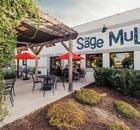














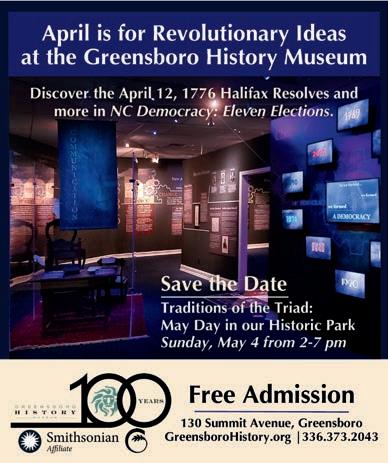


















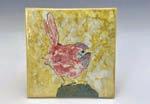







Triad Go Red for Women Experience Koury Convention Center February 7, 2025
Photographs by Yasmin Leonard
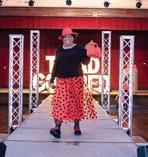

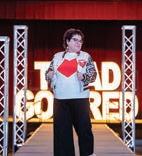



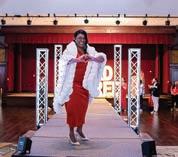
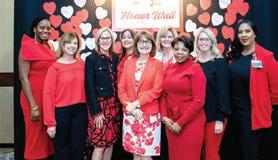









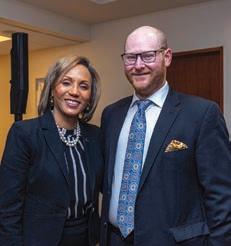

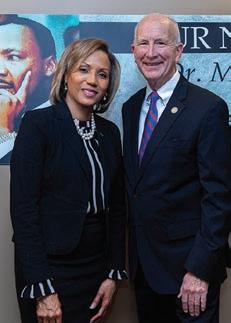
International Civil Rights Center & Museum
January 29, 2025
Photographs by Ivan Saul Cutler
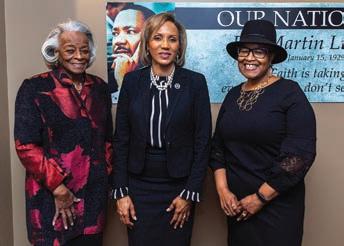

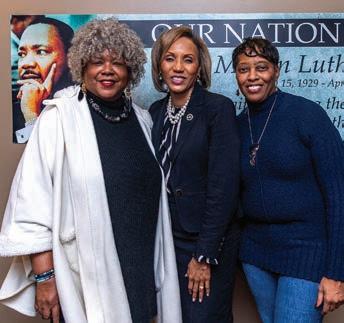
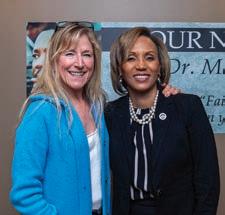
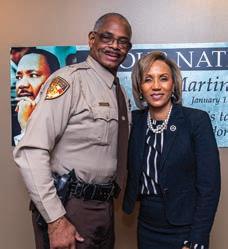


Didya hear the tale of a rooster on the lam?
By Cynthia a dams
The rooster crowed predawn. A rousing, rooster reveille.
Was it a lucid dream, a subliminal sound? After all, I had fallen asleep reading David Sedaris, whose brother, Paul, is nicknamed “the Rooster.”
Unmistakable, again. A rooster’s lusty crow.
“Didya hear that?”
Don nodded, splashing his face. Our morning-has-broken repartee is mostly “Uh huh” or “Not yet,” in answer to “Ready for coffee?” or “Ready to walk the dogs?”
Not “Was that a rooster?”
We live in town, on a park, and have seen foxes, deer, raccoon, possums, chipmunks and squirrels. Once, I encountered a juvenile bear during a morning run. We’ve a variety of birdlife, including hawks and owls. But a rooster? Never.
The real secret to our relationship, we’ve silently agreed, is keeping things muted until coffee cups are filled and emptied, the paper skimmed, and we’ve dressed without walking into closet walls. Neither of us are morning people.
Pulling on sneakers and grabbing dog leashes, we both understood we were going to look for the rooster.
“Sounded close,” Don muttered, and we set out, as if we were advance scouts nearing enemy lines. A Delft-blue sky rimmed the horizon above our usual trail into Latham Park. There was no birdsong beyond harsh complaints from an agitated murder of crows congregating along power lines, and the plaintive moans of mourning doves.
The rooster was nowhere to be seen, but day after day we kept hearing him.
We redoubled efforts to find him during morning and afternoon walks. We began inhaling our cuppa joe and I waved the paper off, determined.
“Didya hear him this morning?” I began asking first off. It felt portentous.
Along the park trail, seeking confirmation from others, too, I’d ask perfect strangers, “Didya hear that?”
“A rooster!” they’d marvel, squinting at me with interest as if I had conjured the bird up. Sometimes his crowing sounded well beyond the prior day’s perimeter, surprising us.
Then, finally, he just appeared as we gardened one Saturday. The Dude himself!
Our wildest terrier alerted us when the rooster strolled over for

a drink from our fountain. Bax trembled with excitement, as if to say, “I found him, and I’m keeping him!”
When I approached the rooster, he nonchalantly disappeared into the woods, strutting along our neighbor’s fence line. His plumage was colorful; a gorgeous fellow.
My grandmothers had kept chickens, and I’d written about raising urban chickens for this magazine; I knew enough to give him space.
A few days later, we spotted him in the shaded perimeter of a parking lot. We froze, pulling the terriers closer. Soon after, we discovered the rooster was gaining an online presence on Nextdoor.
Some had names in mind, including Leghorn Foghorn. Don called him Russell Crowe.
Our editor once had a rooster cleverly called Brewster Roostamante.
But the person resolved to capture the rooster dubbed him the innocuous sounding Todd. (Didn’t he deserve better?) After organizing a small posse for the weekend, a trap was sprung after his fourth or fifth reveille.
Soon after, we both started hearing phantom crowing.
“Didya hear that?” I asked Don, pausing my weeding the weekend of Todd’s entrapment.
“I keep thinking I hear him, too.” He pulled a sad face.
Trundling him off to suburbia, Todd’s captor posted a mugshot. “Todd” was captive, pacing in a dog kennel. Gone was his devil-may-care swagger. Can a rooster look dispirited?
Within 24 hours Todd was transported away to God-knowswhere by God-knows-who. I imagine the clever bird had already figured out how things lay, so to speak.
Because the pairing of roosters and life in a high-density neighborhood, it turns out, is a foul, foul affair. OH

